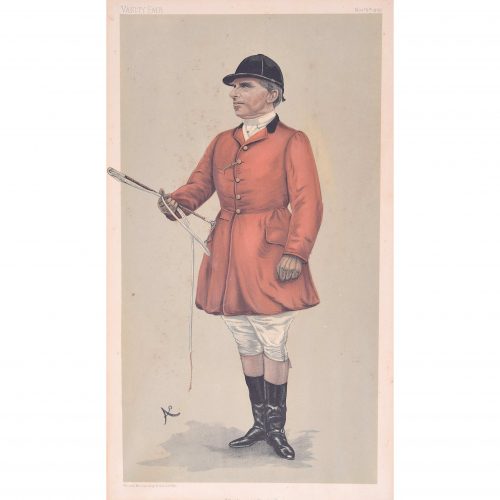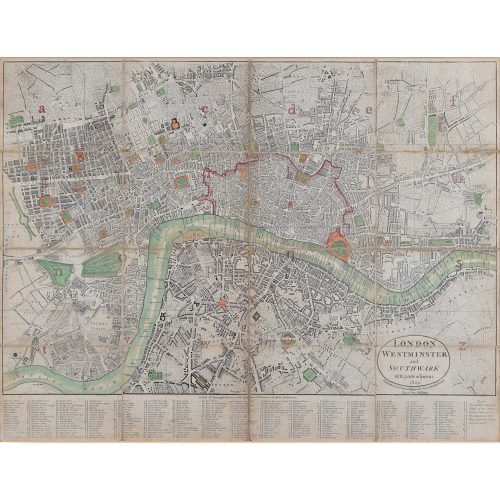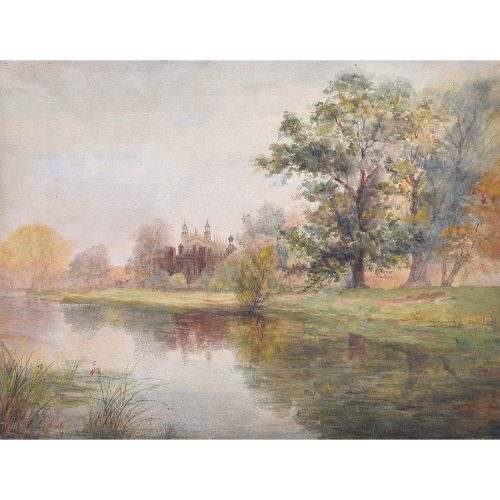-
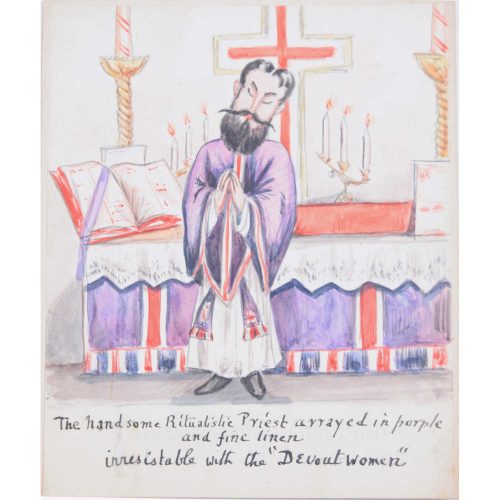
Anonymous, c.1850
'The handsome Ritualistic Priest, arrayed in purple and fine linen irresistible with the "Devout Women"' Caricature
Pen, ink and watercolour 20 x 24 cm By repute this item was found in the rooms of John Keble (1792-1866) at the Hermitage Hotel in Eastbourne after his death in 1866, together with another caricature watercolour of the 'Cotton-ia Worcester-ienisis' which we also have for sale. Condition: Generally very good, slight toning to paper. -
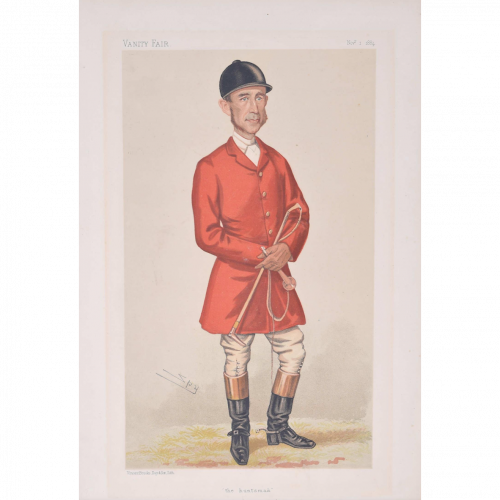
Sir Leslie "Spy" Ward for Vanity Fair Magazine 'The Huntsman': Thomas Firr
1 November 1884 Lithograph 21 x 37 cm Depicting Thomas Firr, Huntsman of the Quorn, on the day of the season's opening meet. The illustrated volume 'Tom Firr of the Quorn: Huntsman Extraordinary' details Firr's days with the hunt, and considers him 'the greatest huntsman in England'. He was huntsman to the Quorn for 27 years from 1872 to 1899. The Quorn Hunt has a claim to be the oldest hunt in the country, having been founded in 1696 by Mr Thomas Boothby of Tooley Park, Leicestershire. Tooley Park lies about eight miles southwest of Leicester, just to the north of the Hinckley road. The hunt takes its name from the village of Quorn, where the hounds were kennelled from 1753 to 1904. If you are interested, please email info@manningfineart.co.uk or call us on 07929 749056. Condition: Good. Mounted to board, some age toning. -
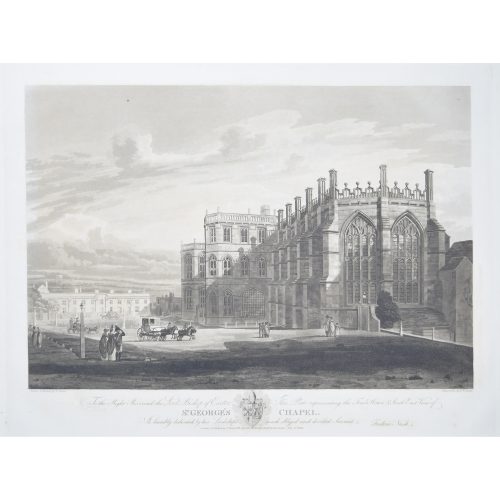
Frederick Nash (1782-1856) Drawn and etched
Engraved by F C LewisSouth East View of St George's Chapel, Windsor
To the Right Reverend the Lord Bishop of Exeter London Published by F Nash, No 6 Asylum Buildings, Westminster Road July 12 1804 39.5x52cm Frederick Nash was born in Lambeth. Initially studying architectural drawing under Thomas Malton he subsequently enrolled at the Royal Academy of Arts. From 1801 to 1809 he worked with the antiquarians John Britton and Edward Wedlake Brayley, subsequently becoming a member of the Society of Painters in Watercolours - a group of painters who had left the Royal Academy following complaints of under-recognition of their works. Latterly primarily a landscape painter he toured the rivers of Germany. -

Frederick Nash (1782-1856) Drawn and etched
Engraved by F C LewisSouth East View of St George's Chapel, Windsor
To the Right Reverend the Lord Bishop of Exeter London Published by F Nash, No 6 Asylum Buildings, Westminster Road July 12 1804 39.5x52cm Frederick Nash was born in Lambeth. Initially studying architectural drawing under Thomas Malton he subsequently enrolled at the Royal Academy of Arts. From 1801 to 1809 he worked with the antiquarians John Britton and Edward Wedlake Brayley, subsequently becoming a member of the Society of Painters in Watercolours - a group of painters who had left the Royal Academy following complaints of under-recognition of their works. Latterly primarily a landscape painter he toured the rivers of Germany. -
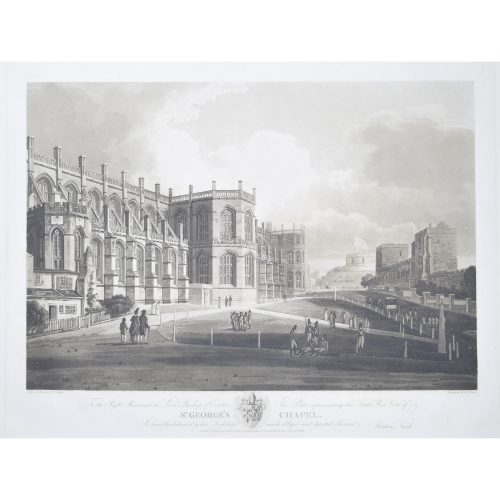
Frederick Nash (1782-1856) Drawn and etched
Engraved by F C LewisSouth West View of St George's Chapel, Windsor
To the Right Reverend the Lord Bishop of Exeter London Published by F Nash, No 6 Asylum Buildings, Westminster Road July 12 1804 39.5x52cm Frederick Nash was born in Lambeth. Initially studying architectural drawing under Thomas Malton he subsequently enrolled at the Royal Academy of Arts. From 1801 to 1809 he worked with the antiquarians John Britton and Edward Wedlake Brayley, subsequently becoming a member of the Society of Painters in Watercolours - a group of painters who had left the Royal Academy following complaints of under-recognition of their works. Latterly primarily a landscape painter he toured the rivers of Germany. -
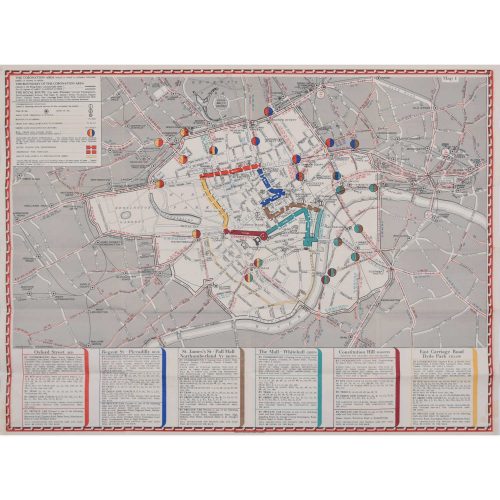
Coronation Arrangements - Map of London (1937)
Lithograph 45 x 60 cm (unfolded) Published by London Transport for the Coronation of George VI, this map illustrates the route the King took in 1936. And best of all, it's just (almost!) as useful in today's London. Condition: generally very good. If you are interested, please email info@manningfineart.co.uk or call us on 07929 749056. -
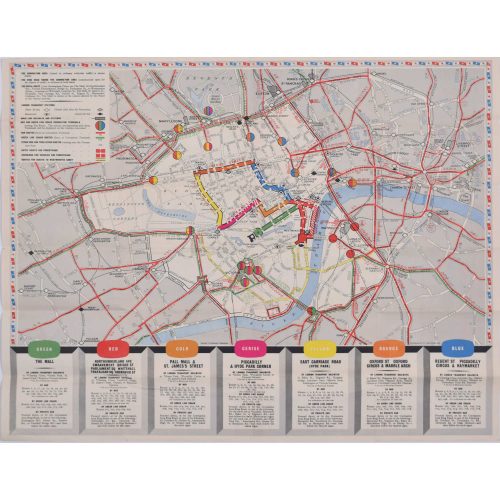
Coronation Arrangements - Map of London (1953)
Lithograph 45 x 60 cm (unfolded) Published by London Transport for the Coronation of Elizabeth II, this delightfully-coloured map illustrates the route taken by the Queen when she was crowned in 1953. Condition: generally very good. If you are interested, please email info@manningfineart.co.uk or call us on 07929 749056. -
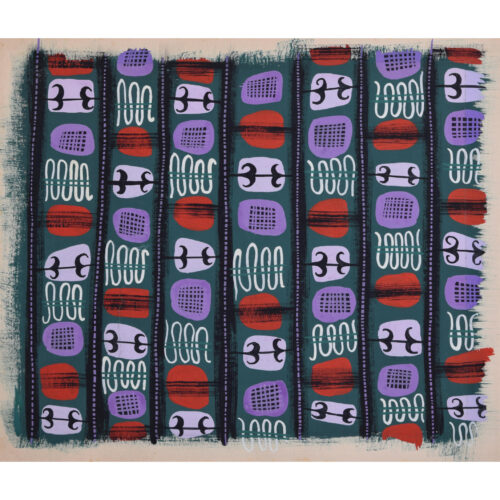
Raymond Weston
Fabric design
Gouache 32 x 37 cm Label to reverse. A fabric design for a dress, produced by a student at the Loughborough College of Art. The colours and forms suggest a mid-century design; the label to the reverse indicates that it would have been machine printed on silk, to be made into a dress. Condition: generally very good. If you are interested, please email info@manningfineart.co.uk or call us on 07929 749056. -
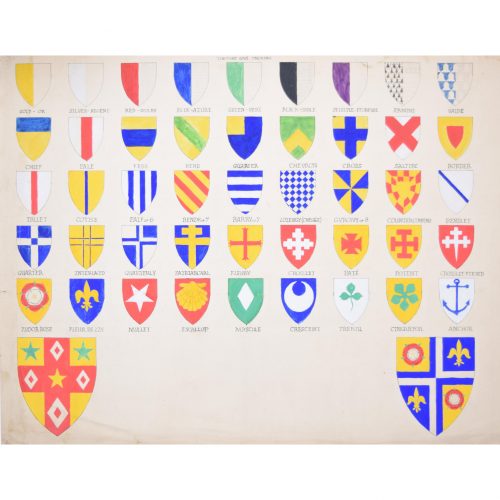
S Clapham (active 1940 - 1960)
A Heraldic Primer
Gouache and pencil 53 x 67 cm A delightful, brightly-coloured study of the various elements of heraldic shields. Condition: good; a few short and neatly-repaired marginal tears. If you are interested, please email info@manningfineart.co.uk or call us on 07929 749056. Click here for other works by the artist. -
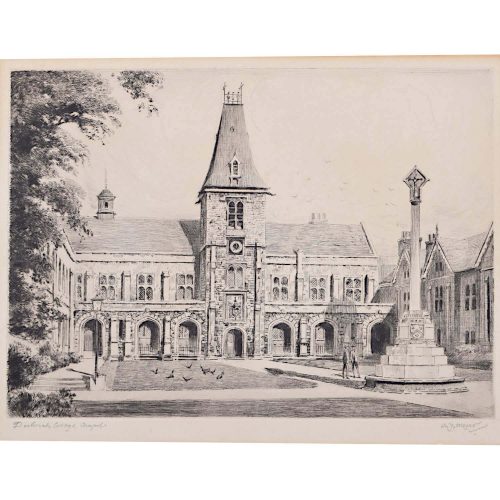
A J Meyer (British, fl 1900-1930) Dulwich College
Etching 22x30cm Sadly little is known of Meyer, an accomplished artist and particularly producer of etchings. He was one of many artists to join the craze for etchings started by Whistler and that died out after the 1929 Wall Street crash. If you are interested email info@manningfineart.co.uk or call us on 07929 749056. Condition: Mounted to board; generally good to very good. -
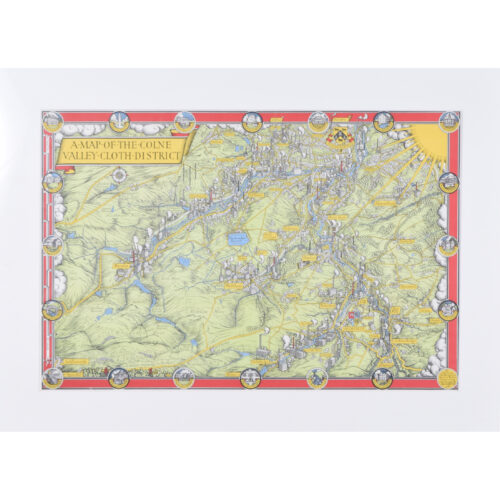
Leslie Macdonald "Max" Gill (1884 - 1947)
A Map of the Colne Valley Cloth District (1946)
Engraving with later hand-colouring 32 x 48 cm Signed in the plate and dated 1946. Produced for Huddersfield and District Woollen Export Group. Gill's vibrant and detailed map depicts the Colne Valley District. The Colne Valley was a loom-weaving area which played a significant role in the development of the Industrial Revolution when water-powered textile mills were brought in. Born in Brighton, Max Gill was the second son in a family of thirteen children; his elder brother was Eric Gill, the typographer and sculptor. Both Gills exhibited significant talent at a young age. Max Gill’s first map was made for a school map-drawing project following which he entered maps into competitions in boys’ magazines. In 1903 he moved to London as assistant to the ecclesiastical architects Sir Charles Nicholson and Hubert Corlette. By 1908 he had started his own architectural practice, but in 1909 Sir Edwin Lutyens commissioned Gill to paint a “wind dial” map for Nashdom, a large house in Buckinghamshire. The wind dial was set over the fireplace and attached to a weather vane on the roof, allowing the occupant to know the direction of the wind from the comfort of the house. He produced seven further wind dials including for Lutyens’s Lindisfarne Castle and for the Allhusen Room at Trinity College, Cambridge. Although Gill continued to practice as an architect, Frank Pick commissioned him to create seven pictorial maps for the Underground, the first being the famous 1913 ‘Wonderground Map of London Town.’ In 1917 he joined the Imperial War Graves Commission’s headstone design committee, designing the typeface and regimental badges. Gill’s memorials for the fallen in the First World War include for Balliol and Worcester Colleges and Christ Church in Oxford. During the 1920s and 30s Gill undertook many commercial commissions for advertising materials. The Empire Marketing Board and Shell-Mex as well as further maps for the Underground. He designed in 1922 the first diagrammatic map of the Underground which provided the foundation for Beck’s more famous map. By the 1930s his major works were murals. Those of the Arctic and Antarctic on the ceilings of the Scott Polar Research Institute in Cambridge are beautiful, but the most impressive is the map of the North Atlantic in the first-class dining room of the Queen Mary (maiden voyage: 1936, now moored at Long Beach, California). During the Second World War he created a series of propaganda posters for the Ministry of Information. Condition: very good. In new hand-finished frame. If you are interested, please email info@manningfineart.co.uk or call us on 07929 749056. Click here for other decorative maps. -
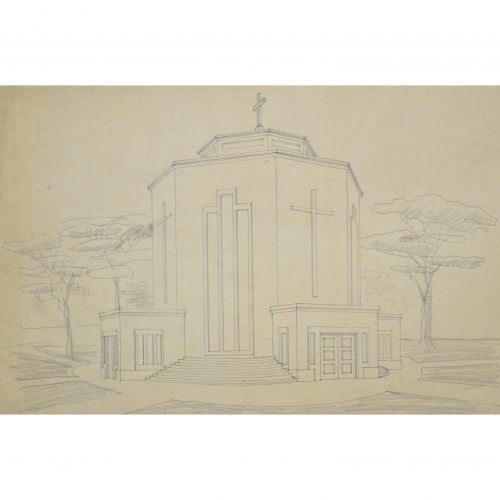
S Clapham (active 1940 - 1960)
A Modernist Church
Pencil 29 x 43 cm A design for an octagonal church in the modernist mid-century style. Clapham was an architect based in Stockwell in London. Condition: generally very good. If you are interested, please email info@manningfineart.co.uk or call us on 07929 749056. Click here for other works by the artist. -
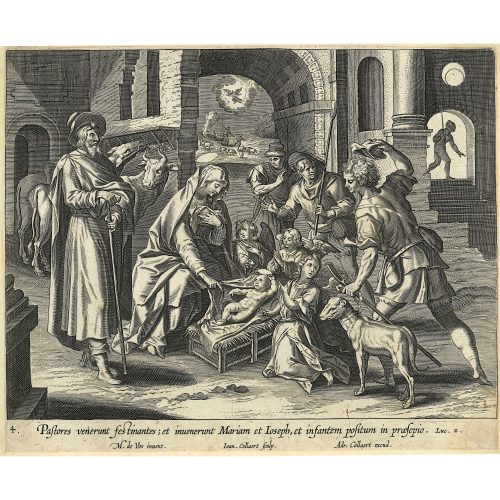
Adriaen Collaert (c. 1560-1618) after Maerten de Vos (1532 - 1603) "Pastores venerunt festinantes; et inuenerunt Mariam et Ioseph, et infantem positum in praesepio" - Luke 2
Engraving, From Vita, Passio, et Resurrectio Iesu Christi first published 1598, this a later edition published by Joannes Galle (1600-1676) 16.5x21.8cm From the Gospel of Luke, Chapter 2 Verse 16 - And the shepherds came with haste, and found Mary, and Joseph, and the babe lying in a manger. Adriaen Collaert was born in Antwerp between 1555 and 1565, becoming wijnmeester of the Guild of St Luke in 1580 - a title reserved for the sons of guild members. The guild of St Luke was generally the city guild for artists. Working for Philip Galle, a Dutch publisher best known for his old master prints, he married Galle's daughter Justa. After learning the principles of engraving in the Netherlands, he spent some years in Italy improving his skill. Upon returning to Flanders he engraved, in accomplished fashion, a great number of plates. His brother, Jan Collaert II, his son, Jan Baptist Collaert II and a grandson were all printmakers. These particular plates are after paintings by Maerten de Vos, a Flemish painter and draughtsman. His father was Pieter de Vos, from whom he learned. From 1550 - 1558 he travelled in Italy, visiting Rome and Venice and becoming master of the Antwerp Guild of St Luke upon his return in 1558. After 1575 he was mainly engaged in producing print designs. If you are interested email info@manningfineart.co.uk or call us on 07929 749056. Condition: Trimmed to plate margins, generally good condition commensurate with age, slight age toning and handling marks as evident from image. -
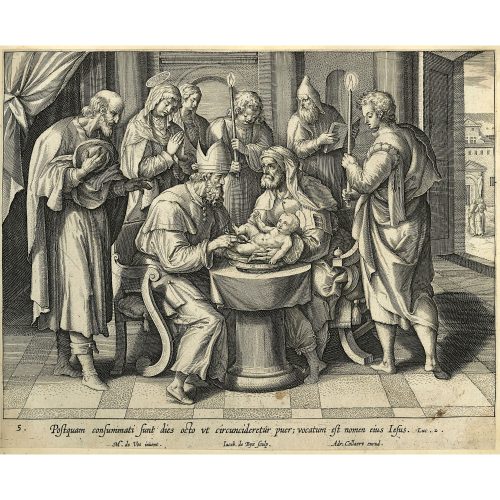
Adriaen Collaert (c. 1560-1618) after Maerten de Vos (1532 - 1603) 5. "Postquam consummati sunt dies octo ut circuncideretur puer; vocatum est nomen eius Iesus" - Luke 2
Engraving, From Vita, Passio, et Resurrectio Iesu Christi first published 1598, this a later edition published by Joannes Galle (1600-1676) 16.5x21.8cm From the Gospel of Luke, Chapter 2 Verse 21 - And when eight days were accomplished for the circumcising of the child, his name was called Jesus. Adriaen Collaert was born in Antwerp between 1555 and 1565, becoming wijnmeester of the Guild of St Luke in 1580 - a title reserved for the sons of guild members. The guild of St Luke was generally the city guild for artists. Working for Philip Galle, a Dutch publisher best known for his old master prints, he married Galle's daughter Justa. After learning the principles of engraving in the Netherlands, he spent some years in Italy improving his skill. Upon returning to Flanders he engraved, in accomplished fashion, a great number of plates. His brother, Jan Collaert II, his son, Jan Baptist Collaert II and a grandson were all printmakers. These particular plates are after paintings by Maerten de Vos, a Flemish painter and draughtsman. His father was Pieter de Vos, from whom he learned. From 1550 - 1558 he travelled in Italy, visiting Rome and Venice and becoming master of the Antwerp Guild of St Luke upon his return in 1558. After 1575 he was mainly engaged in producing print designs. If you are interested email info@manningfineart.co.uk or call us on 07929 749056. Condition: Trimmed to plate margins, generally good condition commensurate with age, slight age toning and handling marks as evident from image. -
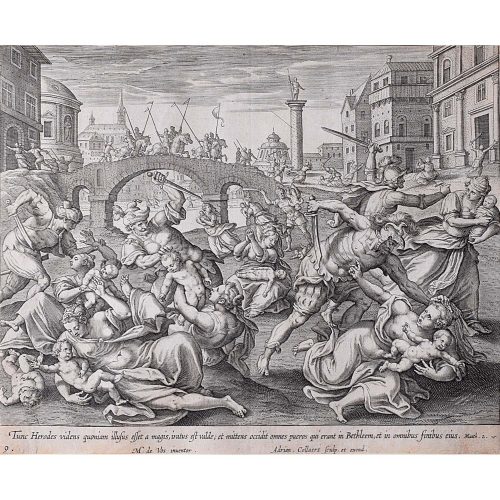
Adriaen Collaert (c. 1560-1618) Jacob de Bye (1581-1640) after Maerten de Vos (1532 - 1603) 9. Tunc Herodes videns quonium illusus esset a magis, iratus est valde; et mittens occidit omnes pueros qui erant in Bethleem, et in omnibus finibus eius Matth. 2.
Engraving From Vita, Passio, et Resurrectio Iesu Christi first published 1598, this a later edition published by Joannes Galle (1600-1676) 16.5x21.8cm Hand-finished black frame included (UK shipping only) From the Gospel of Matthew, chapter 2 "Then Herod, when he saw that he was mocked of the Wise-men, was exceeding wroth, and sent forth, and slew all the male children that were in Bethlehem, and in all the borders thereof". Adrian Collaert was born in Antwerp between 1555 and 1565, becoming wijnmeester of the Guild of St Luke in 1580 - a title reserved for the sons of guild members. The guild of St Luke was generally the city guild for artists. Working for Philip Galle, a Dutch publisher best known for his old master prints, he married Galle's daughter Justa. After learning the principles of engraving in the Netherlands, he spent some years in Italy improving his skill. Upon returning to Flanders he engraved, in accomplished fashion, a great number of plates. His brother, Jan Collaert II, his son, Jan Baptist Collaert II and a grandson were all printmakers. These particular plates are after paintings by Maerten de Vos, a Flemish painter and draughtsman. His father was Pieter de Vos, from whom he learned. From 1550 - 1558 he travelled in Italy, visiting Rome and Venice and becoming master of the Antwerp Guild of St Luke upon his return in 1558. After 1575 he was mainly engaged in producing print designs. If you are interested email info@manningfineart.co.uk or call us on 07929 749056. Condition: Trimmed to plate margins, generally good condition commensurate with age, slight age toning and handling marks as evident from image. -
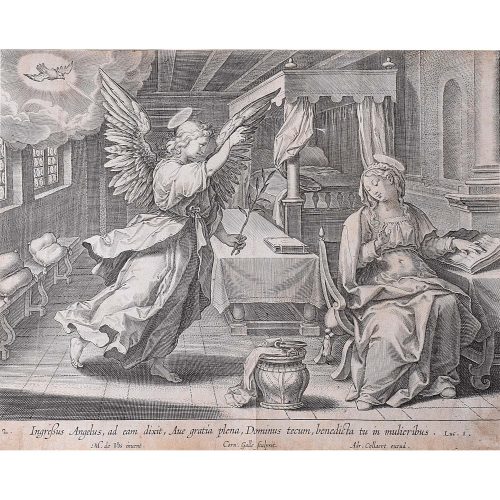
Adriaen Collaert (c. 1560-1618) Cornelius Galle (1576-1650) after Maerten de Vos (1532 - 1603) 2. Ingressus angelus, ad eam dixit, Aue gratia plana, Dominus tecum, benedicta tu in mulieribus. Luke. 1.
Engraving From Vita, Passio, et Resurrectio Iesu Christi first published 1598, this a later edition published by Joannes Galle (1600-1676) 17.5x22cm Hand-finished black frame included (UK shipping only) From the Gospel of Luke, chapter 1 "And the angel came in unto her, and said, Hail, thou that art highly favoured, the lord is with thee". Adrian Collaert was born in Antwerp between 1555 and 1565, becoming wijnmeester of the Guild of St Luke in 1580 - a title reserved for the sons of guild members. The guild of St Luke was generally the city guild for artists. Working for Philip Galle, a Dutch publisher best known for his old master prints, he married Galle's daughter Justa. After learning the principles of engraving in the Netherlands, he spent some years in Italy improving his skill. Upon returning to Flanders he engraved, in accomplished fashion, a great number of plates. His brother, Jan Collaert II, his son, Jan Baptist Collaert II and a grandson were all printmakers. These particular plates are after paintings by Maerten de Vos, a Flemish painter and draughtsman. His father was Pieter de Vos, from whom he learned. From 1550 - 1558 he travelled in Italy, visiting Rome and Venice and becoming master of the Antwerp Guild of St Luke upon his return in 1558. After 1575 he was mainly engaged in producing print designs. If you are interested email info@manningfineart.co.uk or call us on 07929 749056. Condition: Trimmed to plate margins, generally good condition commensurate with age, slight age toning and handling marks as evident from image. -
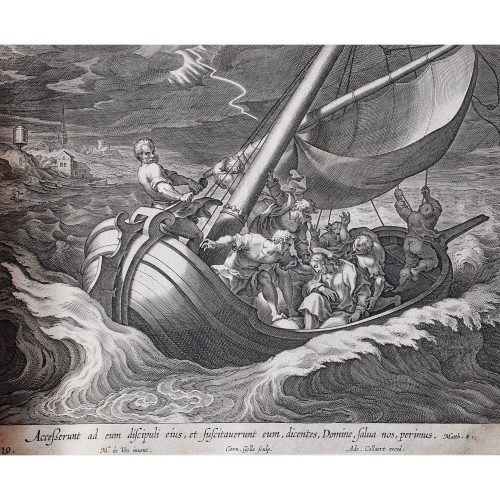
Adriaen Collaert (c. 1560-1618) John de Barbe (1578–1649) after Maerten de Vos (1532 - 1603) 19. Accesserunt ad eum discipuli eius, et suscitaverunt eum, dicentes, Domine, salua nos, perimus. Matth. 8.
Engraving From Vita, Passio, et Resurrectio Iesu Christi first published 1598, this a later edition published by Joannes Galle (1600-1676) 17.5x22cm From the Gospel of Matthew, chapter 8 "Then His disciples came to Him and awoke Him, saying, “Lord, save us! We are perishing!” Adrian Collaert was born in Antwerp between 1555 and 1565, becoming wijnmeester of the Guild of St Luke in 1580 - a title reserved for the sons of guild members. The guild of St Luke was generally the city guild for artists. Working for Philip Galle, a Dutch publisher best known for his old master prints, he married Galle's daughter Justa. After learning the principles of engraving in the Netherlands, he spent some years in Italy improving his skill. Upon returning to Flanders he engraved, in accomplished fashion, a great number of plates. His brother, Jan Collaert II, his son, Jan Baptist Collaert II and a grandson were all printmakers. These particular plates are after paintings by Maerten de Vos, a Flemish painter and draughtsman. His father was Pieter de Vos, from whom he learned. From 1550 - 1558 he travelled in Italy, visiting Rome and Venice and becoming master of the Antwerp Guild of St Luke upon his return in 1558. After 1575 he was mainly engaged in producing print designs. If you are interested email info@manningfineart.co.uk or call us on 07929 749056. Condition: Trimmed to plate margins, generally good condition commensurate with age, slight age toning and handling marks as evident from image. -
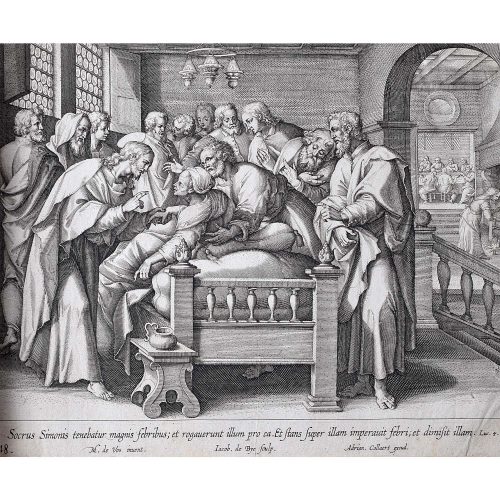
Adriaen Collaert (c. 1560-1618) John de Barbe (1578–1649) after Maerten de Vos (1532 - 1603) 18. Socrus simonis tenebatur magnis febribus; et rogauerunt illum pro ea. Et stans super illum imperauit febri; et dimiset illum. Luke. 4.
Engraving From Vita, Passio, et Resurrectio Iesu Christi first published 1598, this a later edition published by Joannes Galle (1600-1676) 17.5x22cm From the Gospel of Luke, chapter 4 "Simon’s mother-in-law was very sick. She had a high fever. They asked Jesus to do something to help her. He stood very close to her and ordered the sickness to go away". Adrian Collaert was born in Antwerp between 1555 and 1565, becoming wijnmeester of the Guild of St Luke in 1580 - a title reserved for the sons of guild members. The guild of St Luke was generally the city guild for artists. Working for Philip Galle, a Dutch publisher best known for his old master prints, he married Galle's daughter Justa. After learning the principles of engraving in the Netherlands, he spent some years in Italy improving his skill. Upon returning to Flanders he engraved, in accomplished fashion, a great number of plates. His brother, Jan Collaert II, his son, Jan Baptist Collaert II and a grandson were all printmakers. These particular plates are after paintings by Maerten de Vos, a Flemish painter and draughtsman. His father was Pieter de Vos, from whom he learned. From 1550 - 1558 he travelled in Italy, visiting Rome and Venice and becoming master of the Antwerp Guild of St Luke upon his return in 1558. After 1575 he was mainly engaged in producing print designs. If you are interested email info@manningfineart.co.uk or call us on 07929 749056. Condition: Trimmed to plate margins, generally good condition commensurate with age, slight age toning and handling marks as evident from image. -
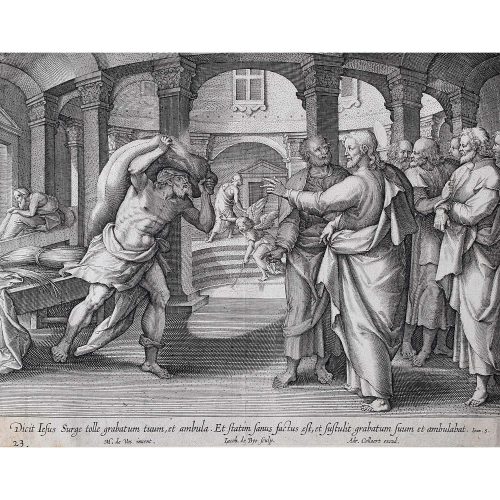
Adriaen Collaert (c. 1560-1618) Jacob de Bye (1581–1640) after Maerten de Vos (1532 - 1603) 23. Dicit iesus Surge tolle grabatum tuum, et ambula. Et statim sanus factus est, et sustulit grabatum suum et ambulabat. John. 5.
Engraving From Vita, Passio, et Resurrectio Iesu Christi first published 1598, this a later edition published by Joannes Galle (1600-1676) 17.5x22cm From the Gospel of John, chapter 5 "He says Rise, take up your bed and walk. He immediately became well, and picked up his bed and walked.” Adrian Collaert was born in Antwerp between 1555 and 1565, becoming wijnmeester of the Guild of St Luke in 1580 - a title reserved for the sons of guild members. The guild of St Luke was generally the city guild for artists. Working for Philip Galle, a Dutch publisher best known for his old master prints, he married Galle's daughter Justa. After learning the principles of engraving in the Netherlands, he spent some years in Italy improving his skill. Upon returning to Flanders he engraved, in accomplished fashion, a great number of plates. His brother, Jan Collaert II, his son, Jan Baptist Collaert II and a grandson were all printmakers. These particular plates are after paintings by Maerten de Vos, a Flemish painter and draughtsman. His father was Pieter de Vos, from whom he learned. From 1550 - 1558 he travelled in Italy, visiting Rome and Venice and becoming master of the Antwerp Guild of St Luke upon his return in 1558. After 1575 he was mainly engaged in producing print designs. If you are interested email info@manningfineart.co.uk or call us on 07929 749056. Condition: Trimmed to plate margins, generally good condition commensurate with age, slight age toning and handling marks as evident from image. -
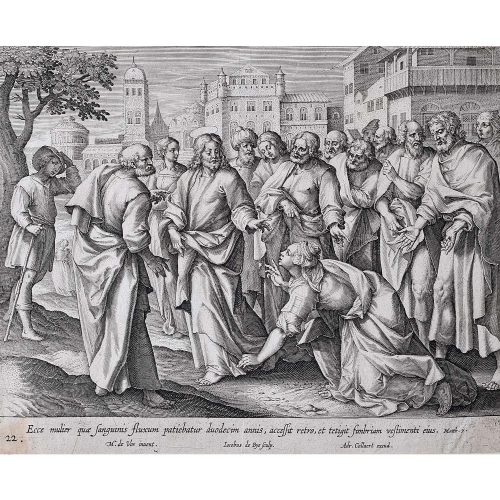
Adriaen Collaert (c. 1560-1618) Jacob de Bye (1581–1640) after Maerten de Vos (1532 - 1603) 22. Ecce mulier quat sanguinis fluxum patiebatur duodecim annis, accessit retro, et tetigit fimbriam vestimenti eius. Matth. 9.
Engraving From Vita, Passio, et Resurrectio Iesu Christi first published 1598, this a later edition published by Joannes Galle (1600-1676) 17.5x22cm From the Gospel of Matthew, chapter 9 "And suddenly, a woman who had a flow of blood for twelve years came from behind and touched the hem of His garment.” Adrian Collaert was born in Antwerp between 1555 and 1565, becoming wijnmeester of the Guild of St Luke in 1580 - a title reserved for the sons of guild members. The guild of St Luke was generally the city guild for artists. Working for Philip Galle, a Dutch publisher best known for his old master prints, he married Galle's daughter Justa. After learning the principles of engraving in the Netherlands, he spent some years in Italy improving his skill. Upon returning to Flanders he engraved, in accomplished fashion, a great number of plates. His brother, Jan Collaert II, his son, Jan Baptist Collaert II and a grandson were all printmakers. These particular plates are after paintings by Maerten de Vos, a Flemish painter and draughtsman. His father was Pieter de Vos, from whom he learned. From 1550 - 1558 he travelled in Italy, visiting Rome and Venice and becoming master of the Antwerp Guild of St Luke upon his return in 1558. After 1575 he was mainly engaged in producing print designs. If you are interested email info@manningfineart.co.uk or call us on 07929 749056. Condition: Trimmed to plate margins, generally good condition commensurate with age, slight age toning and handling marks as evident from image. -
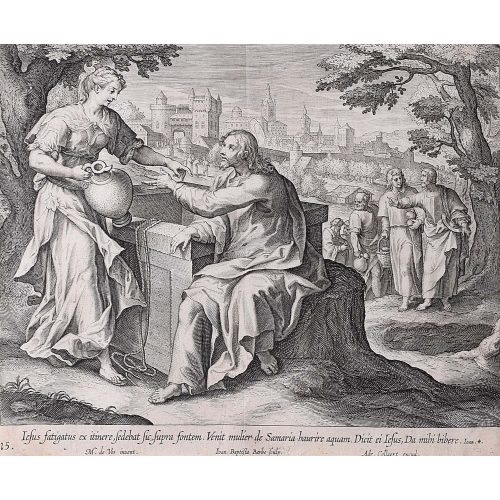
Adriaen Collaert (c. 1560-1618) John de Barbe (1578–1649) after Maerten de Vos (1532 - 1603) 15. Iesus fatigatus ex itinere, sedebat sic supra fontem. Uenit mulier de Samaria haurire aquam. Dicit ei Iesus, Da mihi bibere. John 4.
Engraving From Vita, Passio, et Resurrectio Iesu Christi first published 1598, this a later edition published by Joannes Galle (1600-1676) 17.5x22cm Hand-finished black frame included (UK shipping only) From the Gospel of John, chapter 4 "Jesus, being wearied from his journey, was sitting thus on the well. A Samaritan woman came to draw water. Jesus said to her, “Will you give me a drink?” Adrian Collaert was born in Antwerp between 1555 and 1565, becoming wijnmeester of the Guild of St Luke in 1580 - a title reserved for the sons of guild members. The guild of St Luke was generally the city guild for artists. Working for Philip Galle, a Dutch publisher best known for his old master prints, he married Galle's daughter Justa. After learning the principles of engraving in the Netherlands, he spent some years in Italy improving his skill. Upon returning to Flanders he engraved, in accomplished fashion, a great number of plates. His brother, Jan Collaert II, his son, Jan Baptist Collaert II and a grandson were all printmakers. These particular plates are after paintings by Maerten de Vos, a Flemish painter and draughtsman. His father was Pieter de Vos, from whom he learned. From 1550 - 1558 he travelled in Italy, visiting Rome and Venice and becoming master of the Antwerp Guild of St Luke upon his return in 1558. After 1575 he was mainly engaged in producing print designs. If you are interested email info@manningfineart.co.uk or call us on 07929 749056. Condition: Trimmed to plate margins, generally good condition commensurate with age, slight age toning and handling marks as evident from image. -
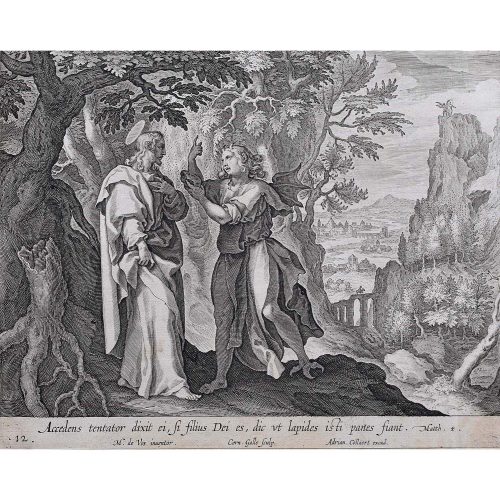
Jean Baptist Barbé (1578?-1649) Adriaen Collaert (c. 1560-1618) after Maerten de Vos (1532 - 1603) 12. Accedens tentator dixit ei fi lius, Dei es, dic vt lapides isti panes fiant. Matt. 4.
Engraving From Vita, Passio, et Resurrectio Iesu Christi first published 1598, this a later edition published by Joannes Galle (1600-1676) 16.5x21.8cm From the Gospel of Matthew, chapter 4 "If thou be the Son of God, command that these stones be made bread" Adriaen Collaert was born in Antwerp between 1555 and 1565, becoming wijnmeester of the Guild of St Luke in 1580 - a title reserved for the sons of guild members. The guild of St Luke was generally the city guild for artists. Working for Philip Galle, a Dutch publisher best known for his old master prints, he married Galle's daughter Justa. After learning the principles of engraving in the Netherlands, he spent some years in Italy improving his skill. Upon returning to Flanders he engraved, in accomplished fashion, a great number of plates. His brother, Jan Collaert II, his son, Jan Baptist Collaert II and a grandson were all printmakers. These particular plates are after paintings by Maerten de Vos, a Flemish painter and draughtsman. His father was Pieter de Vos, from whom he learned. From 1550 - 1558 he travelled in Italy, visiting Rome and Venice and becoming master of the Antwerp Guild of St Luke upon his return in 1558. After 1575 he was mainly engaged in producing print designs. If you are interested email info@manningfineart.co.uk or call us on 07929 749056. Condition: Trimmed to plate margins, generally good condition commensurate with age, slight age toning and handling marks as evident from image. -
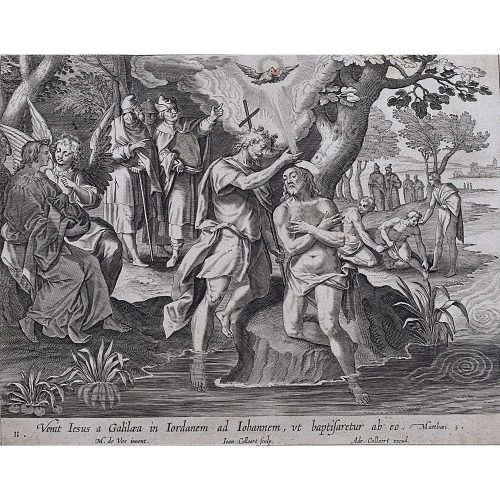
Jean Baptist Barbé (1578?-1649) Adriaen Collaert (c. 1560-1618) after Maerten de Vos (1532 - 1603) 11. Verit Iesus a Galilaea in Iordanem ad Iohannem, vt baptifartur ab eo. Matthew. 3.
Engraving From Vita, Passio, et Resurrectio Iesu Christi first published 1598, this a later edition published by Joannes Galle (1600-1676) 16.5x21.8cm From the Gospel of Matthew, chapter 3 "Then Jesus came from Galilee to the Jordan to be baptized by John." Adriaen Collaert was born in Antwerp between 1555 and 1565, becoming wijnmeester of the Guild of St Luke in 1580 - a title reserved for the sons of guild members. The guild of St Luke was generally the city guild for artists. Working for Philip Galle, a Dutch publisher best known for his old master prints, he married Galle's daughter Justa. After learning the principles of engraving in the Netherlands, he spent some years in Italy improving his skill. Upon returning to Flanders he engraved, in accomplished fashion, a great number of plates. His brother, Jan Collaert II, his son, Jan Baptist Collaert II and a grandson were all printmakers. These particular plates are after paintings by Maerten de Vos, a Flemish painter and draughtsman. His father was Pieter de Vos, from whom he learned. From 1550 - 1558 he travelled in Italy, visiting Rome and Venice and becoming master of the Antwerp Guild of St Luke upon his return in 1558. After 1575 he was mainly engaged in producing print designs. If you are interested email info@manningfineart.co.uk or call us on 07929 749056. Condition: Trimmed to plate margins, generally good condition commensurate with age, slight age toning and handling marks as evident from image. -
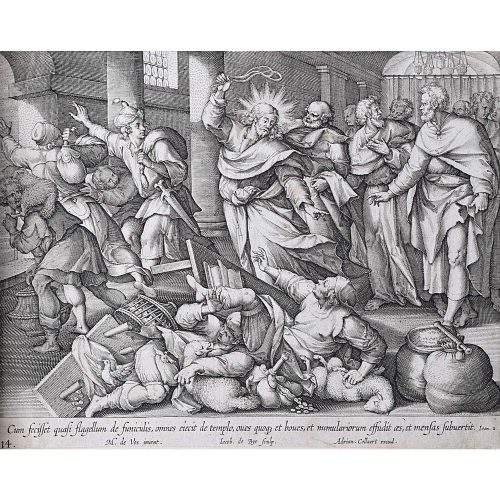
Adriaen Collaert (c. 1560-1618) John de Barbe (1578–1649) after Maerten de Vos (1532 - 1603) 14. Cum fecisset quasi flagellum de funiculis, omnes eiecit de templo, oues quoq et boues, et numulariorum effudit aes, et mensas subuertit. John. 2.
Engraving From Vita, Passio, et Resurrectio Iesu Christi first published 1598, this a later edition published by Joannes Galle (1600-1676) 17.5x22cm Hand-finished black frame included (UK shipping only) From the Gospel of John, chapter 2 "So he made a whip out of cords, and drove all from the temple courts, both sheep and cattle; he scattered the coins of the money changers and overturned their tables”. Adrian Collaert was born in Antwerp between 1555 and 1565, becoming wijnmeester of the Guild of St Luke in 1580 - a title reserved for the sons of guild members. The guild of St Luke was generally the city guild for artists. Working for Philip Galle, a Dutch publisher best known for his old master prints, he married Galle's daughter Justa. After learning the principles of engraving in the Netherlands, he spent some years in Italy improving his skill. Upon returning to Flanders he engraved, in accomplished fashion, a great number of plates. His brother, Jan Collaert II, his son, Jan Baptist Collaert II and a grandson were all printmakers. These particular plates are after paintings by Maerten de Vos, a Flemish painter and draughtsman. His father was Pieter de Vos, from whom he learned. From 1550 - 1558 he travelled in Italy, visiting Rome and Venice and becoming master of the Antwerp Guild of St Luke upon his return in 1558. After 1575 he was mainly engaged in producing print designs. If you are interested email info@manningfineart.co.uk or call us on 07929 749056. Condition: Trimmed to plate margins, generally good condition commensurate with age, slight age toning and handling marks as evident from image. -
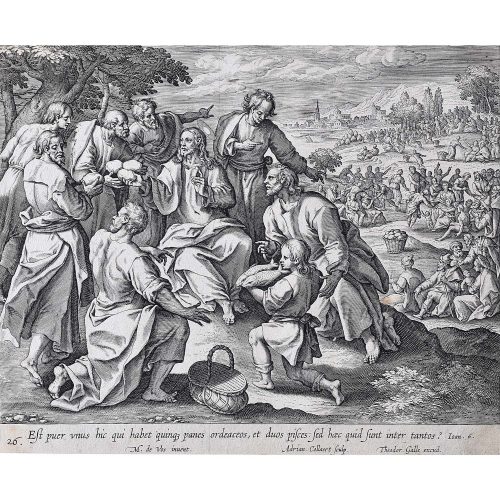
Adriaen Collaert (c. 1560-1618) Theodoor Galle (1571–1633) after Maerten de Vos (1532 - 1603) 26. Est puer vnus hic qui habet quinq panes ordeaceos, et duos: sed haec quid funt tantos? Iohn. 6.
Engraving From Vita, Passio, et Resurrectio Iesu Christi first published 1598, this a later edition published by Joannes Galle (1600-1676) 17.5x22cm From the Gospel of John, chapter 6 "There is a lad here, which hath five barley loaves, one, and two, but what are these for so many?” Adrian Collaert was born in Antwerp between 1555 and 1565, becoming wijnmeester of the Guild of St Luke in 1580 - a title reserved for the sons of guild members. The guild of St Luke was generally the city guild for artists. Working for Philip Galle, a Dutch publisher best known for his old master prints, he married Galle's daughter Justa. After learning the principles of engraving in the Netherlands, he spent some years in Italy improving his skill. Upon returning to Flanders he engraved, in accomplished fashion, a great number of plates. His brother, Jan Collaert II, his son, Jan Baptist Collaert II and a grandson were all printmakers. These particular plates are after paintings by Maerten de Vos, a Flemish painter and draughtsman. His father was Pieter de Vos, from whom he learned. From 1550 - 1558 he travelled in Italy, visiting Rome and Venice and becoming master of the Antwerp Guild of St Luke upon his return in 1558. After 1575 he was mainly engaged in producing print designs. If you are interested email info@manningfineart.co.uk or call us on 07929 749056. Condition: Trimmed to plate margins, generally good condition commensurate with age, slight age toning and handling marks as evident from image. -
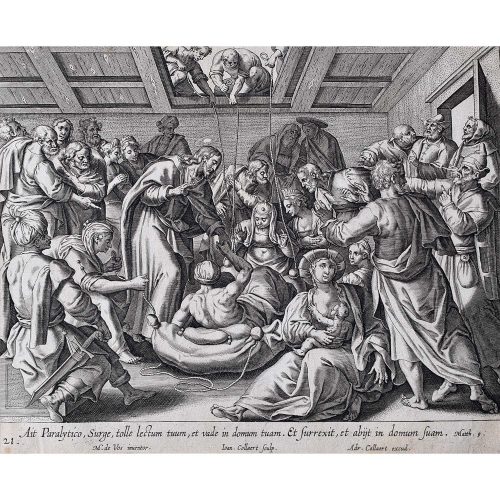
Adriaen Collaert (c. 1560-1618) Jan Collaert (1545–1628) after Maerten de Vos (1532 - 1603) 21. Ait Paralytico, Surge, tolle lectum, et vade in domum tuam. Et surrexit, et abijt in doman suam. Matth. 9.
Engraving From Vita, Passio, et Resurrectio Iesu Christi first published 1598, this a later edition published by Joannes Galle (1600-1676) 17.5x22cm From the Gospel of Matthew, chapter 9 "Get up, pick up your mat, and go home. And the man got up and went home.” Adrian Collaert was born in Antwerp between 1555 and 1565, becoming wijnmeester of the Guild of St Luke in 1580 - a title reserved for the sons of guild members. The guild of St Luke was generally the city guild for artists. Working for Philip Galle, a Dutch publisher best known for his old master prints, he married Galle's daughter Justa. After learning the principles of engraving in the Netherlands, he spent some years in Italy improving his skill. Upon returning to Flanders he engraved, in accomplished fashion, a great number of plates. His brother, Jan Collaert II, his son, Jan Baptist Collaert II and a grandson were all printmakers. These particular plates are after paintings by Maerten de Vos, a Flemish painter and draughtsman. His father was Pieter de Vos, from whom he learned. From 1550 - 1558 he travelled in Italy, visiting Rome and Venice and becoming master of the Antwerp Guild of St Luke upon his return in 1558. After 1575 he was mainly engaged in producing print designs. If you are interested email info@manningfineart.co.uk or call us on 07929 749056. Condition: Trimmed to plate margins, generally good condition commensurate with age, slight age toning and handling marks as evident from image. -
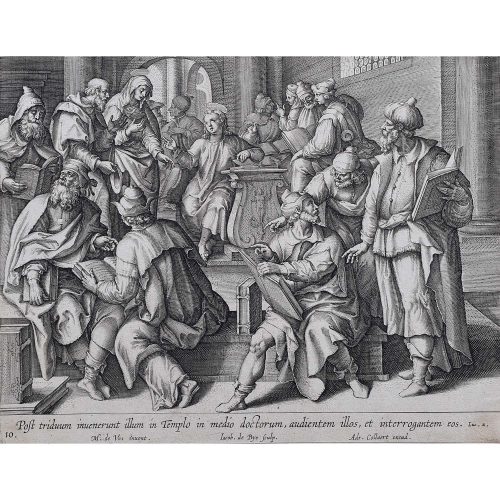
Jean Baptist Barbé (1578?-1649) Adriaen Collaert (c. 1560-1618) after Maerten de Vos (1532 - 1603) 10. Post triduum invenerunt illum in templo in medio doctorum, audientem illos, et interrogante eos. Luc. 2
Engraving From Vita, Passio, et Resurrectio Iesu Christi first published 1598, this a later edition published by Joannes Galle (1600-1676) 16.5x21.8cm From the Gospel of Luke, Chapter 2 After three days they found him in the temple among the doctors, listening to them and asking them questions. Adriaen Collaert was born in Antwerp between 1555 and 1565, becoming wijnmeester of the Guild of St Luke in 1580 - a title reserved for the sons of guild members. The guild of St Luke was generally the city guild for artists. Working for Philip Galle, a Dutch publisher best known for his old master prints, he married Galle's daughter Justa. After learning the principles of engraving in the Netherlands, he spent some years in Italy improving his skill. Upon returning to Flanders he engraved, in accomplished fashion, a great number of plates. His brother, Jan Collaert II, his son, Jan Baptist Collaert II and a grandson were all printmakers. These particular plates are after paintings by Maerten de Vos, a Flemish painter and draughtsman. His father was Pieter de Vos, from whom he learned. From 1550 - 1558 he travelled in Italy, visiting Rome and Venice and becoming master of the Antwerp Guild of St Luke upon his return in 1558. After 1575 he was mainly engaged in producing print designs. If you are interested email info@manningfineart.co.uk or call us on 07929 749056. Condition: Trimmed to plate margins, generally good condition commensurate with age, slight age toning and handling marks as evident from image. -
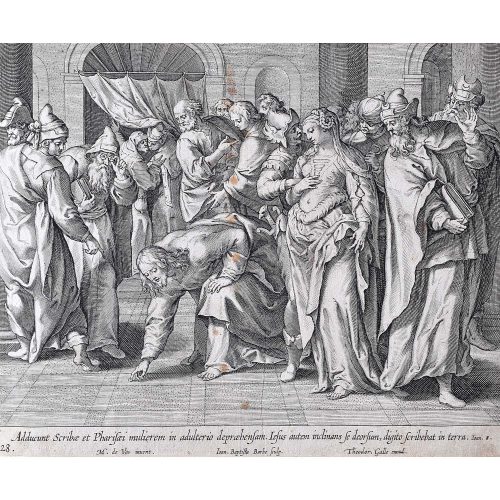
Theodoor Galle (c. 1571-1633) Jean Baptiste Barbe (1578-1649) after Maerten de Vos (1532 - 1603) 28. Adducunt Scibe et Pharisaei mulierem in adulterio deprehensam. Iesus autem inclinans se deorsum, digito scribebat in terra. Iohn. 8.
Engraving From Vita, Passio, et Resurrectio Iesu Christi first published 1598, this a later edition published by Joannes Galle (1600-1676) 17.5x22cm From the Gospel of John, chapter 8 "The scribes and the Pharisees brought a woman who had been caught in adultery, and placing her in the midst they said to him, “Teacher, this woman has been caught in the act of adultery". Jesus bent down and wrote with his finger on the ground.” Adrian Collaert was born in Antwerp between 1555 and 1565, becoming wijnmeester of the Guild of St Luke in 1580 - a title reserved for the sons of guild members. The guild of St Luke was generally the city guild for artists. Working for Philip Galle, a Dutch publisher best known for his old master prints, he married Galle's daughter Justa. After learning the principles of engraving in the Netherlands, he spent some years in Italy improving his skill. Upon returning to Flanders he engraved, in accomplished fashion, a great number of plates. His brother, Jan Collaert II, his son, Jan Baptist Collaert II and a grandson were all printmakers. These particular plates are after paintings by Maerten de Vos, a Flemish painter and draughtsman. His father was Pieter de Vos, from whom he learned. From 1550 - 1558 he travelled in Italy, visiting Rome and Venice and becoming master of the Antwerp Guild of St Luke upon his return in 1558. After 1575 he was mainly engaged in producing print designs. If you are interested email info@manningfineart.co.uk or call us on 07929 749056. Condition: Trimmed to plate margins, generally good condition commensurate with age, slight age toning and handling marks as evident from image. -
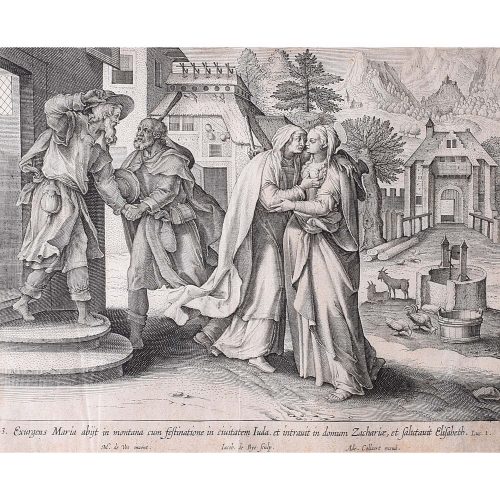
Adriaen Collaert (c. 1560-1618) Jacob de Bye (1581-1640) after Maerten de Vos (1532 - 1603) 3. Exurgens maria abjit in montana cum festinatione in ciuitatem Iuda et intrauit in domum Zacharie, et salutauit Elisabeth . Luc 1.
Engraving From Vita, Passio, et Resurrectio Iesu Christi first published 1598, this a later edition published by Joannes Galle (1600-1676) 17.5x22cm Hand-finished black frame included (UK shipping only) From the Gospel of Luke, chapter 1 "And Mary arose in those days, and went into the hill country with haste, into a city of Juda. And entered into the house of Zacharias, and saluted Elizabeth". Adrian Collaert was born in Antwerp between 1555 and 1565, becoming wijnmeester of the Guild of St Luke in 1580 - a title reserved for the sons of guild members. The guild of St Luke was generally the city guild for artists. Working for Philip Galle, a Dutch publisher best known for his old master prints, he married Galle's daughter Justa. After learning the principles of engraving in the Netherlands, he spent some years in Italy improving his skill. Upon returning to Flanders he engraved, in accomplished fashion, a great number of plates. His brother, Jan Collaert II, his son, Jan Baptist Collaert II and a grandson were all printmakers. These particular plates are after paintings by Maerten de Vos, a Flemish painter and draughtsman. His father was Pieter de Vos, from whom he learned. From 1550 - 1558 he travelled in Italy, visiting Rome and Venice and becoming master of the Antwerp Guild of St Luke upon his return in 1558. After 1575 he was mainly engaged in producing print designs. If you are interested email info@manningfineart.co.uk or call us on 07929 749056. Condition: Trimmed to plate margins, generally good condition commensurate with age, slight age toning and handling marks as evident from image. -
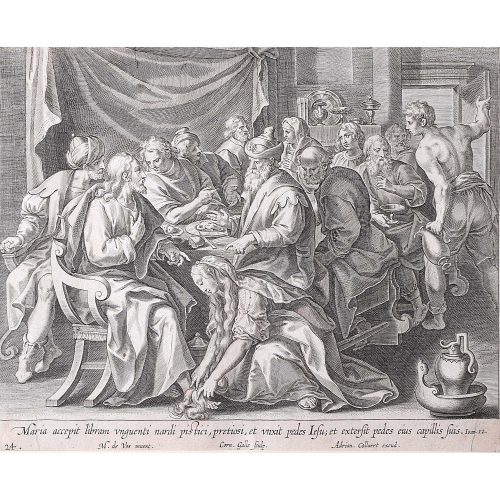
Adriaen Collaert (c. 1560-1618) Cornelius Galle (1576-1650) after Maerten de Vos (1532 - 1603) 24. aria accepit libram unguenti nardi pistici, pretiosti, et vnxit pedes Iefu; et extersit pedes eius capillis suis. John. 12.
Engraving From Vita, Passio, et Resurrectio Iesu Christi first published 1598, this a later edition published by Joannes Galle (1600-1676) 17.5x22cm Hand-finished black frame included (UK shipping only) From the Gospel of John, chapter 12 " Mary therefore took a pound of expensive ointment made from pure nard, and anointed the feet of Jesus and wiped his feet with her hair". Adrian Collaert was born in Antwerp between 1555 and 1565, becoming wijnmeester of the Guild of St Luke in 1580 - a title reserved for the sons of guild members. The guild of St Luke was generally the city guild for artists. Working for Philip Galle, a Dutch publisher best known for his old master prints, he married Galle's daughter Justa. After learning the principles of engraving in the Netherlands, he spent some years in Italy improving his skill. Upon returning to Flanders he engraved, in accomplished fashion, a great number of plates. His brother, Jan Collaert II, his son, Jan Baptist Collaert II and a grandson were all printmakers. These particular plates are after paintings by Maerten de Vos, a Flemish painter and draughtsman. His father was Pieter de Vos, from whom he learned. From 1550 - 1558 he travelled in Italy, visiting Rome and Venice and becoming master of the Antwerp Guild of St Luke upon his return in 1558. After 1575 he was mainly engaged in producing print designs. If you are interested email info@manningfineart.co.uk or call us on 07929 749056. Condition: Trimmed to plate margins, generally good condition commensurate with age, slight age toning and handling marks as evident from image. -
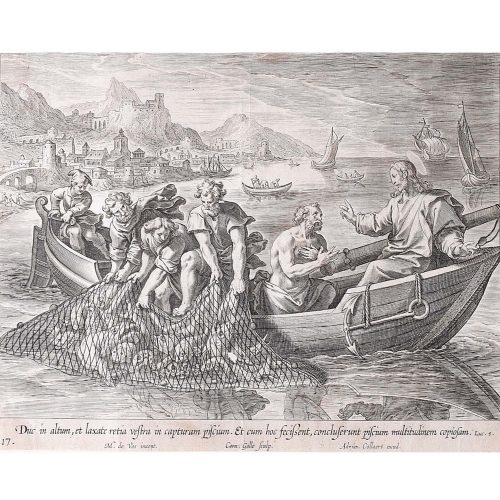
Adriaen Collaert (c. 1560-1618) Cornelius Galle (1576-1650) after Maerten de Vos (1532 - 1603) 17. Duc in altum, et laxate retia vestra in capturam piscium. Et cum hoc fecissent, concluserunt piscium multitudium copiosum. Luke. 5.
Engraving From Vita, Passio, et Resurrectio Iesu Christi first published 1598, this a later edition published by Joannes Galle (1600-1676) 17.5x22cm Hand-finished black frame included (UK shipping only) From the Gospel of Luke, chapter 5 "Put out into the deep and let down your nets for a catch. When they had done this, they enclosed a great quantity of fish". Adrian Collaert was born in Antwerp between 1555 and 1565, becoming wijnmeester of the Guild of St Luke in 1580 - a title reserved for the sons of guild members. The guild of St Luke was generally the city guild for artists. Working for Philip Galle, a Dutch publisher best known for his old master prints, he married Galle's daughter Justa. After learning the principles of engraving in the Netherlands, he spent some years in Italy improving his skill. Upon returning to Flanders he engraved, in accomplished fashion, a great number of plates. His brother, Jan Collaert II, his son, Jan Baptist Collaert II and a grandson were all printmakers. These particular plates are after paintings by Maerten de Vos, a Flemish painter and draughtsman. His father was Pieter de Vos, from whom he learned. From 1550 - 1558 he travelled in Italy, visiting Rome and Venice and becoming master of the Antwerp Guild of St Luke upon his return in 1558. After 1575 he was mainly engaged in producing print designs. If you are interested email info@manningfineart.co.uk or call us on 07929 749056. Condition: Trimmed to plate margins, generally good condition commensurate with age, slight age toning and handling marks as evident from image. -
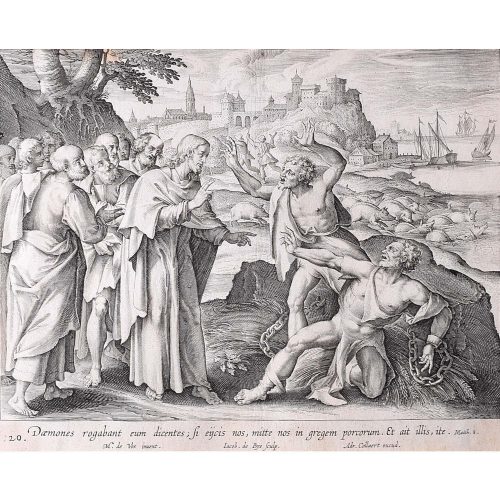
Adriaen Collaert (c. 1560-1618) Jacob de Bye (1581-1640) after Maerten de Vos (1532 - 1603) 20. Daemones rogabant eum dicentes ; si eijcis nos, mitte nos in gregem porcorum. Et ait illis, ite. Matth. 8.
Engraving From Vita, Passio, et Resurrectio Iesu Christi first published 1598, this a later edition published by Joannes Galle (1600-1676) 16.5x21.8cm Hand-finished black frame included (UK shipping only) From the Gospel of Matthew, chapter 8 "The demons begged Jesus, “If you drive us out, send us into the herd. He said to them, “Go!" Adriaen Collaert was born in Antwerp between 1555 and 1565, becoming wijnmeester of the Guild of St Luke in 1580 - a title reserved for the sons of guild members. The guild of St Luke was generally the city guild for artists. Working for Philip Galle, a Dutch publisher best known for his old master prints, he married Galle's daughter Justa. After learning the principles of engraving in the Netherlands, he spent some years in Italy improving his skill. Upon returning to Flanders he engraved, in accomplished fashion, a great number of plates. His brother, Jan Collaert II, his son, Jan Baptist Collaert II and a grandson were all printmakers. These particular plates are after paintings by Maerten de Vos, a Flemish painter and draughtsman. His father was Pieter de Vos, from whom he learned. From 1550 - 1558 he travelled in Italy, visiting Rome and Venice and becoming master of the Antwerp Guild of St Luke upon his return in 1558. After 1575 he was mainly engaged in producing print designs. If you are interested email info@manningfineart.co.uk or call us on 07929 749056. Condition: Trimmed to plate margins, generally good condition commensurate with age, slight age toning and handling marks as evident from image. -
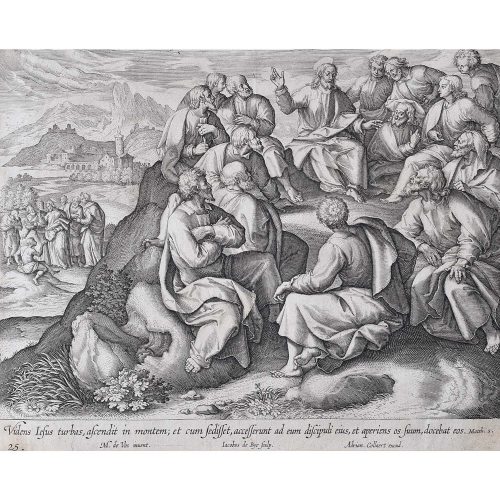
Adriaen Collaert (c. 1560-1618) Jacob de Bye (1581–1640) after Maerten de Vos (1532 - 1603) 25. Videns Iesus turbas, ascendit in montem; et cum sedisset, accesserunt ad eum discipuli eius, et aperiens os suum, docebat eos. Matth. 5.
Engraving From Vita, Passio, et Resurrectio Iesu Christi first published 1598, this a later edition published by Joannes Galle (1600-1676) 17.5x22cm From the Gospel of Matthew, chapter 5 "And seeing the multitudes, He went up on a mountain, and when He was seated His disciples came to Him.” Adrian Collaert was born in Antwerp between 1555 and 1565, becoming wijnmeester of the Guild of St Luke in 1580 - a title reserved for the sons of guild members. The guild of St Luke was generally the city guild for artists. Working for Philip Galle, a Dutch publisher best known for his old master prints, he married Galle's daughter Justa. After learning the principles of engraving in the Netherlands, he spent some years in Italy improving his skill. Upon returning to Flanders he engraved, in accomplished fashion, a great number of plates. His brother, Jan Collaert II, his son, Jan Baptist Collaert II and a grandson were all printmakers. These particular plates are after paintings by Maerten de Vos, a Flemish painter and draughtsman. His father was Pieter de Vos, from whom he learned. From 1550 - 1558 he travelled in Italy, visiting Rome and Venice and becoming master of the Antwerp Guild of St Luke upon his return in 1558. After 1575 he was mainly engaged in producing print designs. If you are interested email info@manningfineart.co.uk or call us on 07929 749056. Condition: Trimmed to plate margins, generally good condition commensurate with age, slight age toning and handling marks as evident from image. -

Adriaen Collaert (c. 1560-1618) Jacob de Bye (1685-?) after Maerten de Vos (1532 - 1603) 27. Assumit Iesus Petrum et Iacobum et Ioannem fratrem eius, et ducit illos in montem excelsum seorsum; et transfiguratus est eos. Matth. 17.
Engraving From Vita, Passio, et Resurrectio Iesu Christi first published 1598, this a later edition published by Joannes Galle (1600-1676) 17.5x22cm From the Gospel of Matthew, chapter 17 "After six days Jesus took with him Peter, James and John the brother of James, and led them up a high mountain by themselves. There he was transfigured before them.” Adrian Collaert was born in Antwerp between 1555 and 1565, becoming wijnmeester of the Guild of St Luke in 1580 - a title reserved for the sons of guild members. The guild of St Luke was generally the city guild for artists. Working for Philip Galle, a Dutch publisher best known for his old master prints, he married Galle's daughter Justa. After learning the principles of engraving in the Netherlands, he spent some years in Italy improving his skill. Upon returning to Flanders he engraved, in accomplished fashion, a great number of plates. His brother, Jan Collaert II, his son, Jan Baptist Collaert II and a grandson were all printmakers. These particular plates are after paintings by Maerten de Vos, a Flemish painter and draughtsman. His father was Pieter de Vos, from whom he learned. From 1550 - 1558 he travelled in Italy, visiting Rome and Venice and becoming master of the Antwerp Guild of St Luke upon his return in 1558. After 1575 he was mainly engaged in producing print designs. If you are interested email info@manningfineart.co.uk or call us on 07929 749056. Condition: Trimmed to plate margins, generally good condition commensurate with age, slight age toning and handling marks as evident from image. -
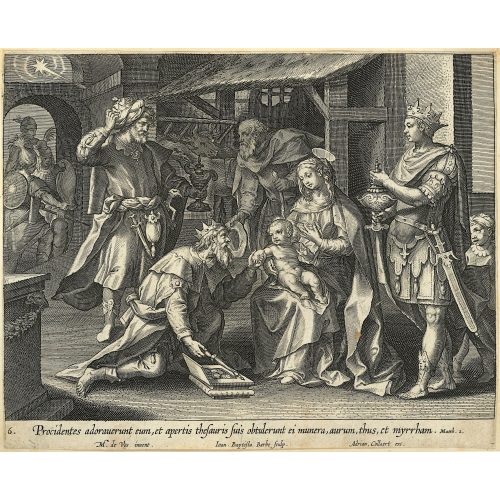
Jean Baptist Barbé (1578?-1649) Adriaen Collaert (c. 1560-1618) after Maerten de Vos (1532 - 1603) 6. "Procidentes adoravuerunt eum, et apertis thesauris suis obtulerunt ei munera, aurum, thus, et myrrham" - Matth 2
Engraving From Vita, Passio, et Resurrectio Iesu Christi first published 1598, this a later edition published by Joannes Galle (1600-1676) 16.5x21.8cm From the Gospel of Matthew, Chapter 2 Verse 11 - and fell down and worshipped him: and when they had opened their treasures, they presented unto him gifts; gold, and frankincense and myrrh. The star hangs over the stable door, as the three Magi present their treasures to Our Lord, sitting upon Mary's knee, St Joseph in attendance behind. Adriaen Collaert was born in Antwerp between 1555 and 1565, becoming wijnmeester of the Guild of St Luke in 1580 - a title reserved for the sons of guild members. The guild of St Luke was generally the city guild for artists. Working for Philip Galle, a Dutch publisher best known for his old master prints, he married Galle's daughter Justa. After learning the principles of engraving in the Netherlands, he spent some years in Italy improving his skill. Upon returning to Flanders he engraved, in accomplished fashion, a great number of plates. His brother, Jan Collaert II, his son, Jan Baptist Collaert II and a grandson were all printmakers. These particular plates are after paintings by Maerten de Vos, a Flemish painter and draughtsman. His father was Pieter de Vos, from whom he learned. From 1550 - 1558 he travelled in Italy, visiting Rome and Venice and becoming master of the Antwerp Guild of St Luke upon his return in 1558. After 1575 he was mainly engaged in producing print designs. If you are interested email info@manningfineart.co.uk or call us on 07929 749056. Condition: Trimmed to plate margins, generally good condition commensurate with age, slight age toning and handling marks as evident from image. -
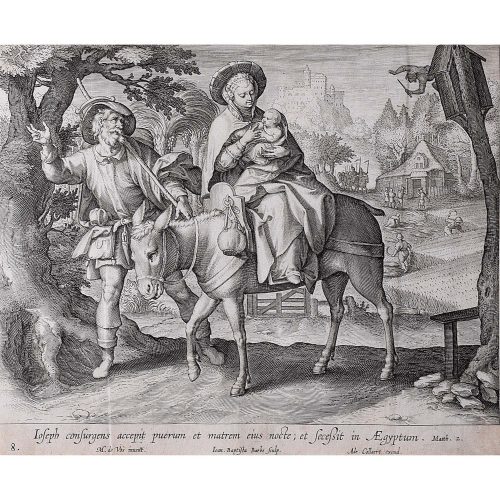
Adriaen Collaert (c. 1560-1618) John de Barbe (1578–1649) after Maerten de Vos (1532 - 1603) 8. Ioseph consurgens accepit puerum et matrem eius nocte; et secessit in Aegyptum. Matth. 2.
Engraving From Vita, Passio, et Resurrectio Iesu Christi first published 1598, this a later edition published by Joannes Galle (1600-1676) 17.5x22cm Hand-finished black frame included (UK shipping only) From the Gospel of Matthew, chapter 2 "Joseph arose, he took the young child and his mother by night; and left for Egypt". Adrian Collaert was born in Antwerp between 1555 and 1565, becoming wijnmeester of the Guild of St Luke in 1580 - a title reserved for the sons of guild members. The guild of St Luke was generally the city guild for artists. Working for Philip Galle, a Dutch publisher best known for his old master prints, he married Galle's daughter Justa. After learning the principles of engraving in the Netherlands, he spent some years in Italy improving his skill. Upon returning to Flanders he engraved, in accomplished fashion, a great number of plates. His brother, Jan Collaert II, his son, Jan Baptist Collaert II and a grandson were all printmakers. These particular plates are after paintings by Maerten de Vos, a Flemish painter and draughtsman. His father was Pieter de Vos, from whom he learned. From 1550 - 1558 he travelled in Italy, visiting Rome and Venice and becoming master of the Antwerp Guild of St Luke upon his return in 1558. After 1575 he was mainly engaged in producing print designs. If you are interested email info@manningfineart.co.uk or call us on 07929 749056. Condition: Trimmed to plate margins, generally good condition commensurate with age, slight age toning and handling marks as evident from image. -
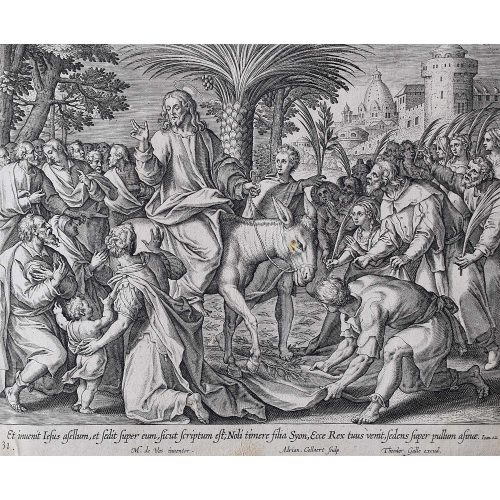
Adrian Collaert (1560–1618) Theodoor Galle (c. 1571-1633) after Maerten de Vos (1532 - 1603) 31. Et inuenit Iesus afellum, et sedit super eum, sicut scriptum est; Noli timere filia Syon, Ecce Rex tuus venit, sedens super pullion asine. Iohn. 12.
Engraving From Vita, Passio, et Resurrectio Iesu Christi first published 1598, this a later edition published by Joannes Galle (1600-1676) 17.5x22cm From the Gospel of John, chapter 12 "Finding a young donkey, Jesus sat on it, as it is written: Fear not, daughter of Zion; Behold, your King is coming, Sitting on a donkey’s colt." Adrian Collaert was born in Antwerp between 1555 and 1565, becoming wijnmeester of the Guild of St Luke in 1580 - a title reserved for the sons of guild members. The guild of St Luke was generally the city guild for artists. Working for Philip Galle, a Dutch publisher best known for his old master prints, he married Galle's daughter Justa. After learning the principles of engraving in the Netherlands, he spent some years in Italy improving his skill. Upon returning to Flanders he engraved, in accomplished fashion, a great number of plates. His brother, Jan Collaert II, his son, Jan Baptist Collaert II and a grandson were all printmakers. These particular plates are after paintings by Maerten de Vos, a Flemish painter and draughtsman. His father was Pieter de Vos, from whom he learned. From 1550 - 1558 he travelled in Italy, visiting Rome and Venice and becoming master of the Antwerp Guild of St Luke upon his return in 1558. After 1575 he was mainly engaged in producing print designs. If you are interested email info@manningfineart.co.uk or call us on 07929 749056. Condition: Trimmed to plate margins, generally good condition commensurate with age, slight age toning and handling marks as evident from image. -
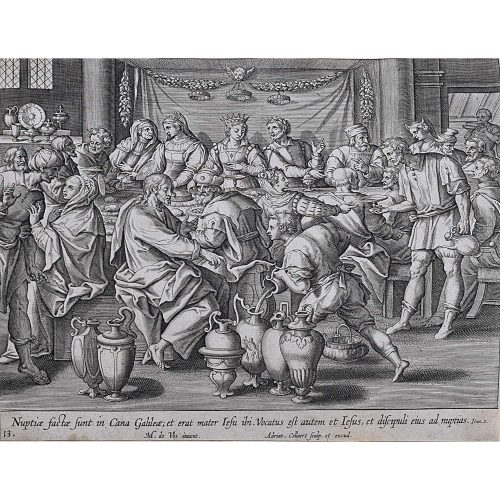
Jean Baptist Barbé (1578?-1649) Adriaen Collaert (c. 1560-1618) after Maerten de Vos (1532 - 1603) 13. nuptia facta sunt in cana galilaeae; et erat mater Iefu ibi. Vocatus eft autem et Iefus, et difcipuli eius ad nuptias. Ioan. 2.
Engraving From Vita, Passio, et Resurrectio Iesu Christi first published 1598, this a later edition published by Joannes Galle (1600-1676) 16.5x21.8cm From the Gospel of John, chapter 2 "On the third day a wedding took place at Cana in Galilee. Jesus’ mother was there, and Jesus and His disciples had also been invited to the wedding. When the wine ran out, Jesus’ mother said to Him, “They have no more wine." Adriaen Collaert was born in Antwerp between 1555 and 1565, becoming wijnmeester of the Guild of St Luke in 1580 - a title reserved for the sons of guild members. The guild of St Luke was generally the city guild for artists. Working for Philip Galle, a Dutch publisher best known for his old master prints, he married Galle's daughter Justa. After learning the principles of engraving in the Netherlands, he spent some years in Italy improving his skill. Upon returning to Flanders he engraved, in accomplished fashion, a great number of plates. His brother, Jan Collaert II, his son, Jan Baptist Collaert II and a grandson were all printmakers. These particular plates are after paintings by Maerten de Vos, a Flemish painter and draughtsman. His father was Pieter de Vos, from whom he learned. From 1550 - 1558 he travelled in Italy, visiting Rome and Venice and becoming master of the Antwerp Guild of St Luke upon his return in 1558. After 1575 he was mainly engaged in producing print designs. If you are interested email info@manningfineart.co.uk or call us on 07929 749056. Condition: Trimmed to plate margins, generally good condition commensurate with age, slight age toning and handling marks as evident from image. -
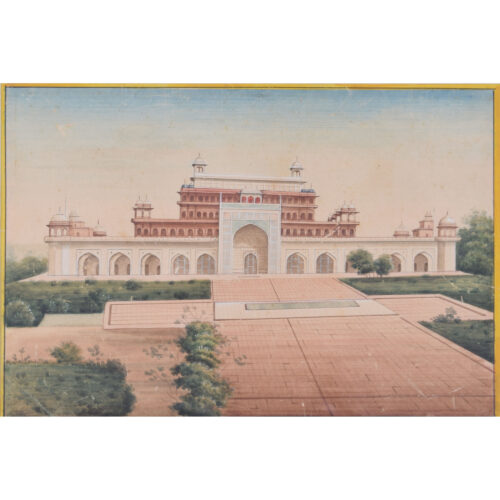
Akbar's Tomb, Agra
Watercolour 13 x 20 cmA 20th century watercolour by an unknown artist of Akbar's Tomb, Agra, the mausoleum of the Mughal emperor Akbar. We have three other Indian architectural views by the same artist available.Condition: generally very good; one or two small scratches as visible in photographs. If you are interested, please email info@manningfineart.co.uk or call us on 07929 749056. Click here for other works from the same series. -
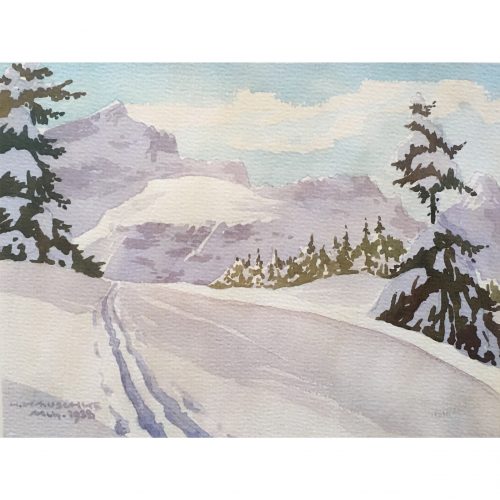
Hermann Kauschke Alpspitze, Zugspitze und Waxenstein (1938)
Watercolour 14.5 x 19.5 cm Inscribed "Alpspitze, Zugspitze u. Waxenstein - original Aquarell". Signed and dated. A beautiful snowy scene depicting three Bavarian mountains: the Alpspitze, Zugspitze, and Waxenstein. Kauschke's view emphasises the wintry quietude of the snow-covered trees and mountains. The winter sun reflects on the freshly fallen snow, and a pair of ski tracks disappear into the distance. If you are interested, please email info@manningfineart.co.uk or call us on 07929 749056. Condition: excellent. -
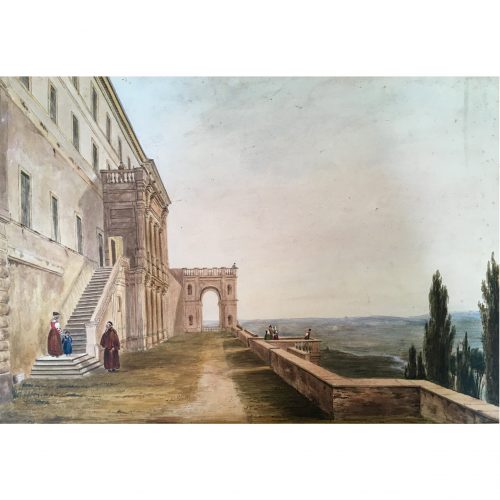
Anonymous
'View from an Italian Villa'
19th century Watercolour 31.5 x 44cm If you are interested email info@manningfineart.co.uk or call us on 07929 749056. Condition: Good. A few foxing spots to top right. -
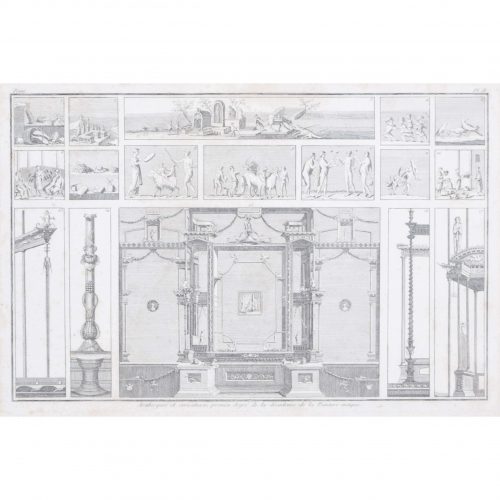
Arabesques and caricatures
Engraving 24.5 x 36 cm Condition: good. If you’d like to know more, please email info@manningfineart.co.uk or call us on 07929 749056. -
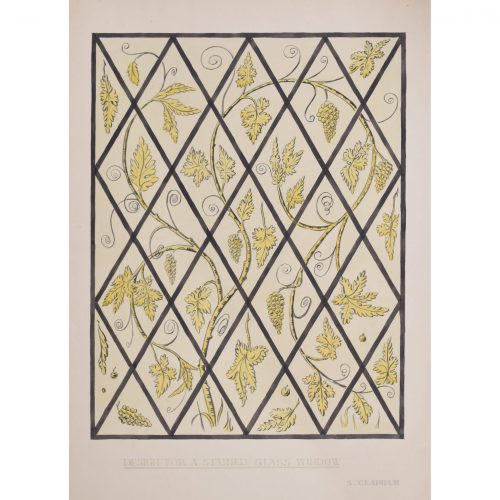
S Clapham (active 1940 - 1960)
Designs for a Stained Glass Window
Watercolour 71 x 56 cm Signed lower right. A beautiful stained glass window design in the medievalist Arts and Crafts style popularised by William Morris in the 1890s. Clapham was an architect based in Stockwell in London. Condition: very good. If you are interested, please email info@manningfineart.co.uk or call us on 07929 749056. Click here for other works by the artist. -
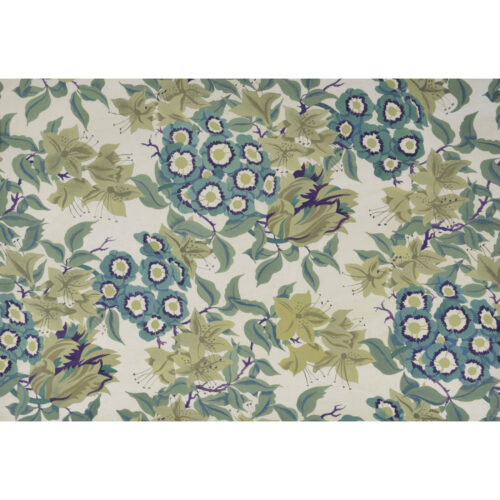
Glasgow School of Art
Wallpaper design
Gouache 33 x 48 cm An Arts and Crafts wallpaper design in the style popularised by William Morris, featuring pansies and lilies in shades of green, blue, and purple. Condition: generally very good; a few very faint spots. If you are interested, please email info@manningfineart.co.uk or call us on 07929 749056. -
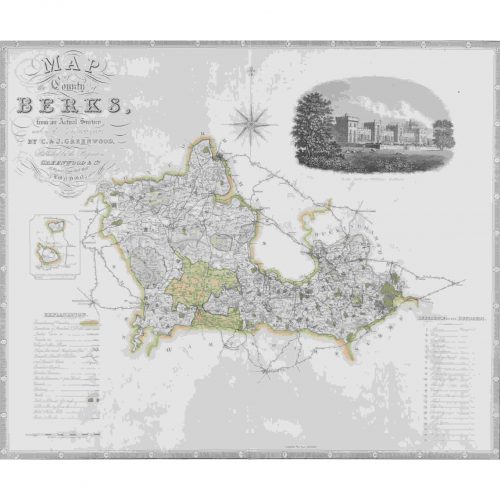
John Dower (1825 - 1901)
Map of Berkshire from an actual survey made in the years 1822 & 1823
Engraving 57 x 69 cm A large antique engraved map of Berkshire. Condition: good; some light staining. If you’d like to know more, please email info@manningfineart.co.uk or call us on 07929 749056. -

after Samuel Buck (1696 - 1779) and Nathaniel Buck (active 1724 - 1759)
The South View of Bindon Abbey, in the County of Dorset (1733)
Engraving 20 x 37 cm An engraved view of Bindon Abbey, a Cistercian monastery on the River Frome in Dorset. The monastery was founded in 1149 by William de Glastonia on the site since known as Little Bindon near Bindon Hill. In 1172 the monastery moved to a site near Wool, and was supported by the house of Plantagenet. The abbey was scheduled for Dissolution in 1536, and finally dissolved in 1539. Only ruins remain. Samuel and Nathaniel Buck were brothers and notable 18th century architectural artists, best known for their depictions of ancient castles and monasteries entitled 'Buck's Antiquities' and those of townscapes of England and Wales, ''Sea-Ports and Capital Towns''. Little is known about the brothers' lives. Samuel was born in Yorkshire and died in penury in London in 1779, and was buried in the churchyard of St Clement Danes. Nathaniel pre-deceased him, dying between 1759 and 1774. Condition: generally good; some age toning; mounted to board; sheet trimmed outside platemark. If you are interested, please email info@manningfineart.co.uk or call us on 07929 749056. -
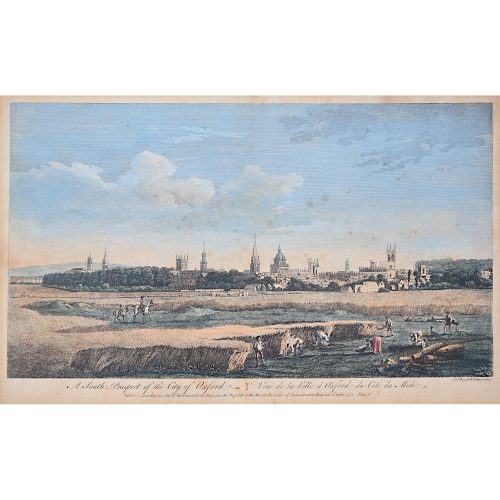
John Boydell (1719-1804)
A South Prospect of the City of Oxford
Hand-coloured engraving published 1751 in the series Four Views of Oxford 28x44.5cm If you are interested email info@manningfineart.co.uk or call us on 07929 749056. One of the most influential Georgian printsellers, Boydell was apprenticed to William Henry Toms at the age of 21, studying drawing at the St Marin's Lane Academy. From 1755 he imported foreign prints in great numbers. He became Mayor of London in 1790. -
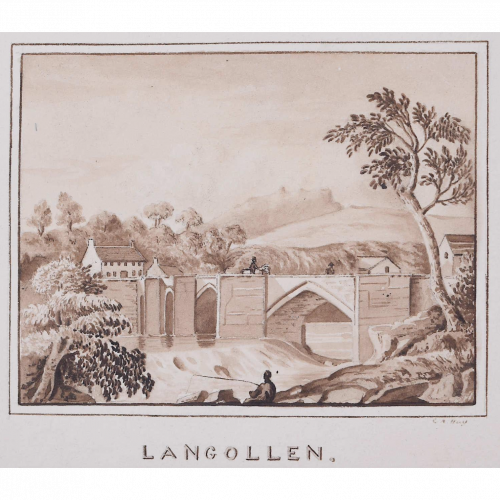
C.A. Hay
Llangollen Bridge, Wales (early 19th century)
Pen, ink and monochrome watercolour 8 x 12 cm Llangollen Bridge is built across the River Dee at the North end of the high street of Llangollen in the county of Denbigshire in Wales. The Bridge is listed as one of the seven wonders of Wales and is Grade I listed. There has been a bridge across the Dee at Llangollen since at least 1284. Some historians believe that the bridge was constructed in the 1540s; there is evidence of sepulchral slabs within the bridge's masonry, indicating that it was rebuilt following the dissolution of Henry VIII's dissolution of the monasteries. We also have in stock an en-suite watercolour of the nearby Valle Crucis abbey, from which some of the bridge's stone might have been taken. Condition: Generally very good. Signed lower right. -
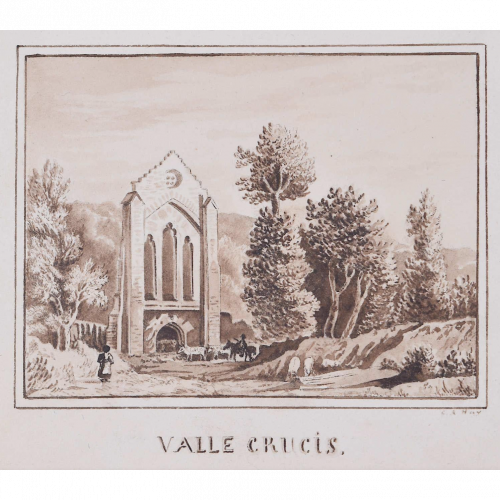
C.A. Hay
Valle Crucis Abbey, Wales (early 19th century)
Pen, ink and monochrome watercolour 8 x 12 cm Valle Crucis is a Cistercian abbey located in Llantysilio in Denbighshire, Wales. The abbey was built in 1201 by Madog ap Gruffydd Maelor, Prince of Powys Fadog. In 1537, at the height of Henry VIII's Dissolution of the Monasteries, Valle Crucis was dissolved and fell into disrepair. The abbey is now a ruin, though large parts of the original structure still survive. We also have in stock an en-suite watercolour of the nearby Llangollen Bridge; it is likely that some of the abbey's stone was used to build the bridge after the abbey had been dissolved. Condition: Generally very good. Signed lower right. -
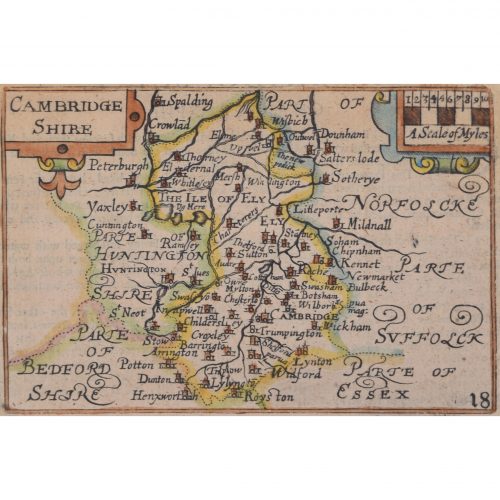
Pieter van den Keere (1571 - circa 1646) after John Speed (1551 or 1552 - 1629)
Map of Cambridgeshire (1627)
Engraving 8 x 12 cm A beautifully coloured map of Cambridgeshire, with an antique description of the county to the reverse. The map, along with many others, was published in Speed's atlas, 'The Theatre of the Empire of Great Britaine', first published in 1611. This particular miniature edition of the 'Theatre' was published in miniature by George Humble in 1627, entitled 'England Wales Scotland and Ireland Described and Abridged With ye Historic Relation of things worthy memory from a farr larger Voulume. Done by John Speed.’ Speed's original map was likely engraved for this edition by Peter van den Keere. van den Keere's maps soon came to be known as "Miniature Speeds". John Speed was an English cartographer, chronologer and historian. The son of a citizen and Merchant Taylor in London, he rose from his family occupation to accept the task of drawing together and revising the histories, topographies and maps of the Kingdoms of Great Britain as an exposition of the union of their monarchies in the person of King James I and VI. He accomplished this with remarkable success, with the support and assistance of the leading antiquarian scholars of his generation. He drew upon and improved the shire maps of Christopher Saxton, John Norden and others, being the first to incorporate the hundred-boundaries into them, and he was the surveyor and originator of many of the town or city plans inset within them. His work helped to define early modern concepts of British national identity. His Biblical genealogies were also formally associated with the first edition of the King James Bible. He is among the most famous of English mapmakers. George Humble (1572 - 1640) was an English publisher, known for his publication of John Speed's 'The theatre of the empire of Great Britaine,' the first comprehensive atlas depicting the British Isles, and his later 'A prospect of the most famous parts of the World,' the first English world atlas. Pieter van den Keere was a Flemish engraver, publisher, and globe maker who worked in England and the Dutch Republic. Condition: generally very good; some age toning. If you’d like to know more, please email info@manningfineart.co.uk or call us on 07929 749056. -
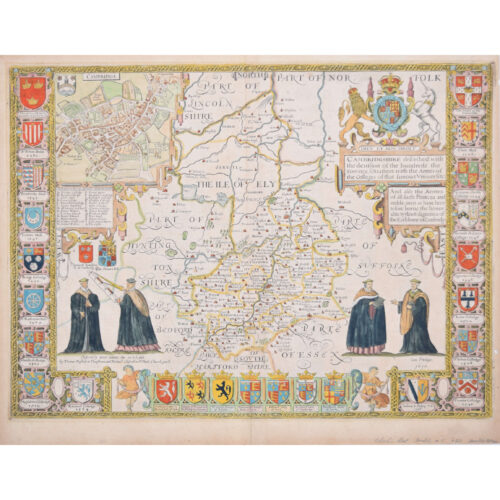
John Speed (1551 or 1552 - 1629)
Map of Cambridgeshire
Engraving with later hand colouring 39 x 53 cm A beautifully coloured map of Cambridgeshire, with an antique description of the county to the reverse. The map, along with many others, was published in Speed's atlas, 'The Theatre of the Empire of Great Britaine', first published in 1611. The map is populated by four figures in academic dress, and bordered on all sides by college crests. John Speed was an English cartographer, chronologer and historian. The son of a citizen and Merchant Taylor in London, he rose from his family occupation to accept the task of drawing together and revising the histories, topographies and maps of the Kingdoms of Great Britain as an exposition of the union of their monarchies in the person of King James I and VI. He accomplished this with remarkable success, with the support and assistance of the leading antiquarian scholars of his generation. He drew upon and improved the shire maps of Christopher Saxton, John Norden and others, being the first to incorporate the hundred-boundaries into them, and he was the surveyor and originator of many of the town or city plans inset within them. His work helped to define early modern concepts of British national identity. His Biblical genealogies were also formally associated with the first edition of the King James Bible. He is among the most famous of English mapmakers. Condition: generally very good; one tiny hole to right side just beyond plate mark. If you’d like to know more, please email info@manningfineart.co.uk or call us on 07929 749056. Click here for more Cambridge pictures. -

William Kip (active 1598 - 1610) after Christopher Saxton (1540 - 1610)
Map of Cambridgeshire (1637)
Engraving with later hand colouring 29 x 32 cm An antique map of Cambridgeshire. The map was originally published in William Camden's atlas 'Britannia', which was first published in 1586. William Kip was a goldsmith and map engraver. He was born in Utrecht in the Netherlands and moved to London to pursue his career as an engraver. Alongside William Hole, Kip re-engraved Christopher Saxton's 1574 county maps for publication in Camden's 'Britannia', and it is this venture for which he is most well-known. Christopher Saxton was an English cartographer who produced the first county maps of England and Wales. Between 1574 and 1578 he engraved maps of every county in Britain, and compiled them into an atlas in 1579. These maps bore Queen Elizabeth I's arms as well as those of Saxton's patron, Thomas Seckford. Condition: generally good; faint evidence of old staining. If you are interested, please email info@manningfineart.co.uk or call us on 07929 749056. Click here for more maps and general pictures of Cambridge. -
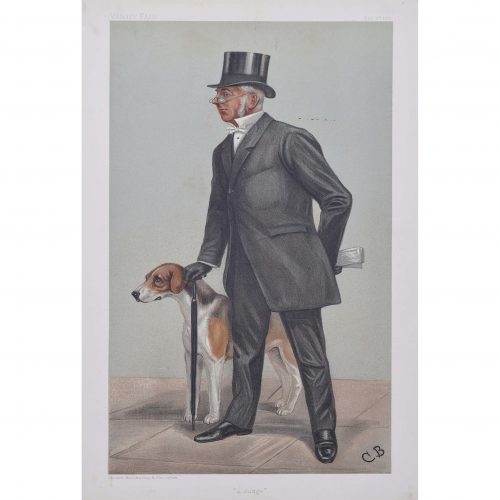
Cuthbert "CB" Bradley for Vanity Fair Magazine 'A Judge': The Rev Cecil Legard
11 July 1901 Lithograph 21 x 37 cm CB's cartoon depicts The Rev Cecil Legard (1843-1918), the Rector of Cottesbrooke and heir to the baronetcy. As well as a clergyman, Legard was a noted sportsman and hound expert; he was a steeplechase rider, and also edited the Foxhound Kennel Stud Book. CB depicts him judging hounds, excellently outfitted; as the biography on the reverse of the mounted lithograph notes, he might be 'the best judge of a foxhound in England'. A copy of the cartoon is held by the Kingston Lacy Estate in Dorset. Cuthbert Bradley was also a sporting man - he famously authored 'Fox-Hunting from Shire to Shire with Many Noted Packs' and worked as a sporting journalist for The Field. As well as illustrating for Vanity Fair, he painted polo and foxhunting scenes, and other pictures of equestrian interest. The majority of his Vanity Fair cartoons are of hunting men. The Vanity Fair magazine of 1868 to 1914 was subtitled 'A Weekly Show of Political, Social and Literary Wares'. Founded by Thomas Gibson Bowles, who aimed to expose the contemporary vanities of Victorian society, it featured regular full-page, colour lithographs of famous (or infamous) contemporary figures. It is for these caricatures that the original Vanity Fair is best known today. If you are interested, please email info@manningfineart.co.uk or call us on 07929 749056. Condition: Generally very good. -
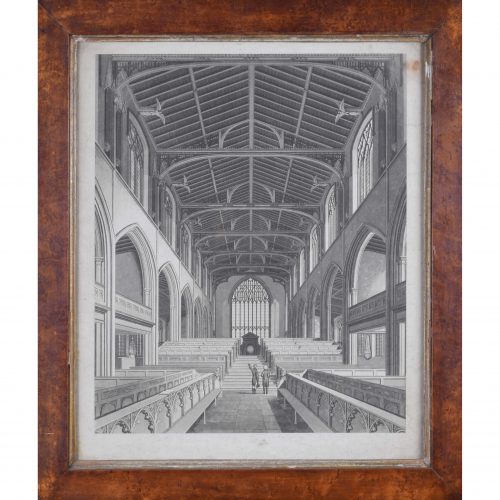
Chapel Interior (circa 1800)
Engraving 49 x 40 cm An engraving of a magnificent chapel interior. Two men tour the chapel, one gesticulating towards the spectacular design of the chancel window. Condition: good. Some gentle discolouration; in faux burr-maple frame. If you’d like to know more, please email info@manningfineart.co.uk or call us on 07929 749056. -
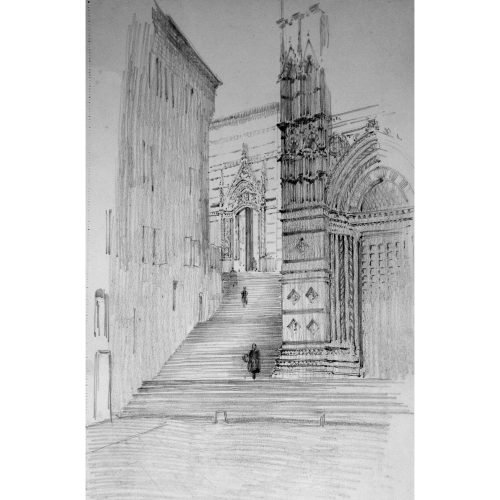
Christopher Wyndham Hughes (1881-1961) Italian Church Entrance
Pencil drawing c.1930s 35 x 23cm Born in St Albans, in Hertfordshire UK, Hughes was a painter, illustrator, printmaker and teacher. He served in the First World War in the 7th Battalion Wiltshire Regiment being awarded a Military Cross in the 1917 New Years Honours List and attaining the rank of Colonel. Subsequently he taught art at Marlborough College. He was taught painting by his father, Wyndham Hughes, who was an expert in stained glass and ecclesiastical decoration. This is from a series of drawing we have of an Italian trip, to see some others, scroll down to "More from this Seller" and below it click on "See all from this seller." If you are interested email info@manningfineart.co.uk or call us on 07929 749056. Condition: Good. -
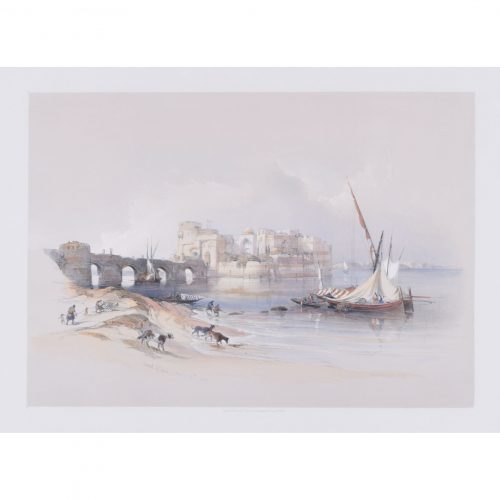
David Roberts (1769 - 1864)
Citadel of Sidon - April 28th, 1839 (published 1943)
Lithograph with hand-colouring 23 x 35 cm (sheet size 17.5 x 24.5 cm) The Citadel of Sidon, or Sidon Sea Castle, was built by crusaders in the thirteenth century as a fortress of the holy land. This lithograph is part of David Roberts' series of views of the Holy Land, which he produced from sketches made during lengthy tours of the Near East in the 1830s. Egypt was much in vogue at this time, and travellers, collectors and lovers of antiquities were keen to buy works inspired by the East or depicting the great monuments of ancient Egypt; Roberts was more than happy to produce pictures on this lucrative theme. Queen Victoria was one of his 400 subscribers, and her set of lithographs is still held by the Royal Collection Trust. The lithographer Louis Haghe worked with Roberts to turn the original sketches into high-quality lithographs, which were then published in the 1840s by the printer F. G. Moon in London. David Roberts RA RBA was a Scottish painter known for his Orientalist pictures. He was elected as a Royal Academician in 1841. -
Sale!
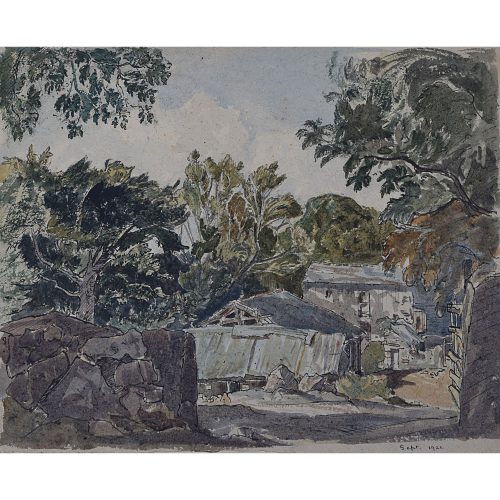
Claude Muncaster (1903-1974) Farmstead and Trees
Dated Sept 1921 Signed on reverse with additional sketches of figures Watercolour 22x28cm Claude Grahame Muncaster, RWS, ROI, RBA, SMA was the son of Oliver Hall RA. At the age of fifteen his career as a landscape painter began, and he soon took to the seas, spending the 1920s and 30s travelling the world with his sketchbook in a series of vessels. With the outbreak of war and he joined the RNVR training as a navigator. Having left school at fifteen his mathematics was very weak and it was a relief for all when his artistic talents meant he was recruited as a camofleur. A master of capturing seascapes he was therefore able to hide huge ships ‘in plain sight’ with clever disguises. After the war he painted for the Royal Family and was a frequent guest at Sandringham. Claude Muncaster was a watercolourist known for his landscapes and maritime scenes. He was born Grahame Hall, the son of the Royal Academician Oliver Hall who taught his son to paint from an early age; Grahame first exhibited his work aged 15 and a few years later was showing at the RA. However, he adopted the name Claude Muncaster in 1922 to dissociate his career from that of his father. Muncaster’s primary choice of subject matter came from a genuine love of the sea. He made several long-distance sea voyages, including one around the Horn as a deckhand in the windjammer Olivebank in 1931, which he described in ‘Rolling Round the Horn’, published in 1933. Armed with a sketchbook, his aim was to be able to ‘paint ships and the sea with greater authority’. This he certainly achieved, perfectly capturing the limpid first light of morning over the Port of Aden, the choppy rain-grey waters of the Bay of Biscay and a streak of sunlight through gathering storm clouds at dusk in Exeter. He became an Associate of the Royal Watercolour Society in 1931 and was a founder member, and later President, of the Royal Society of Marine Artists. During the Second World War, Muncaster served in the Royal Naval Volunteer Reserve (RNVR) from 1940-44, training as a navigator before going on to advise on the camouflage of ships, and also worked as an official war artist. In ‘Still Morning at Aden’ (1944) he depicts Allied warships in this safe anchorage in the Middle East; the back is stamped with Admiralty approval. In 1946-7 he was commissioned by the Queen to produce watercolours of the royal residences at Windsor, Sandringham and Balmoral; the Duke of Edinburgh, in a foreword to a biography of Muncaster, recalls looking at these and considering the artist’s ‘unerring instinct for a subject’, his sense of atmosphere. Other commissions included large panoramas of the Thames and of Bradford. His career also included work as an etcher, illustrator, writer, lecturer and broadcaster, and his paintings can be found in the Royal Academy, Tate, National Maritime Museum Cornwall, National Railway Museum and Royal Air Force Museum. Condition: generally good, few isolated spots to sky as can be seen in the magnified version of the picture. If you are interested email info@manningfineart.co.uk or call us on 07929 749056. -
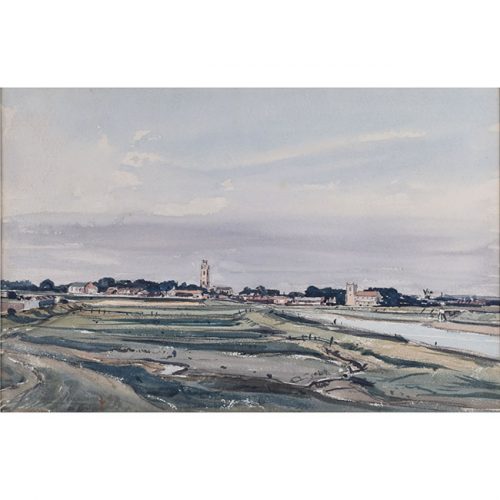
Claude Muncaster (1903-1974)
Boston Stump
Signed Pen and watercolour 23x34cm (Titled erroneously to reverse 'North Norfolk Churches' Click here for biographical details and other works by the artist. If you are interested email info@manningfineart.co.uk or call us on 07929 749056. -
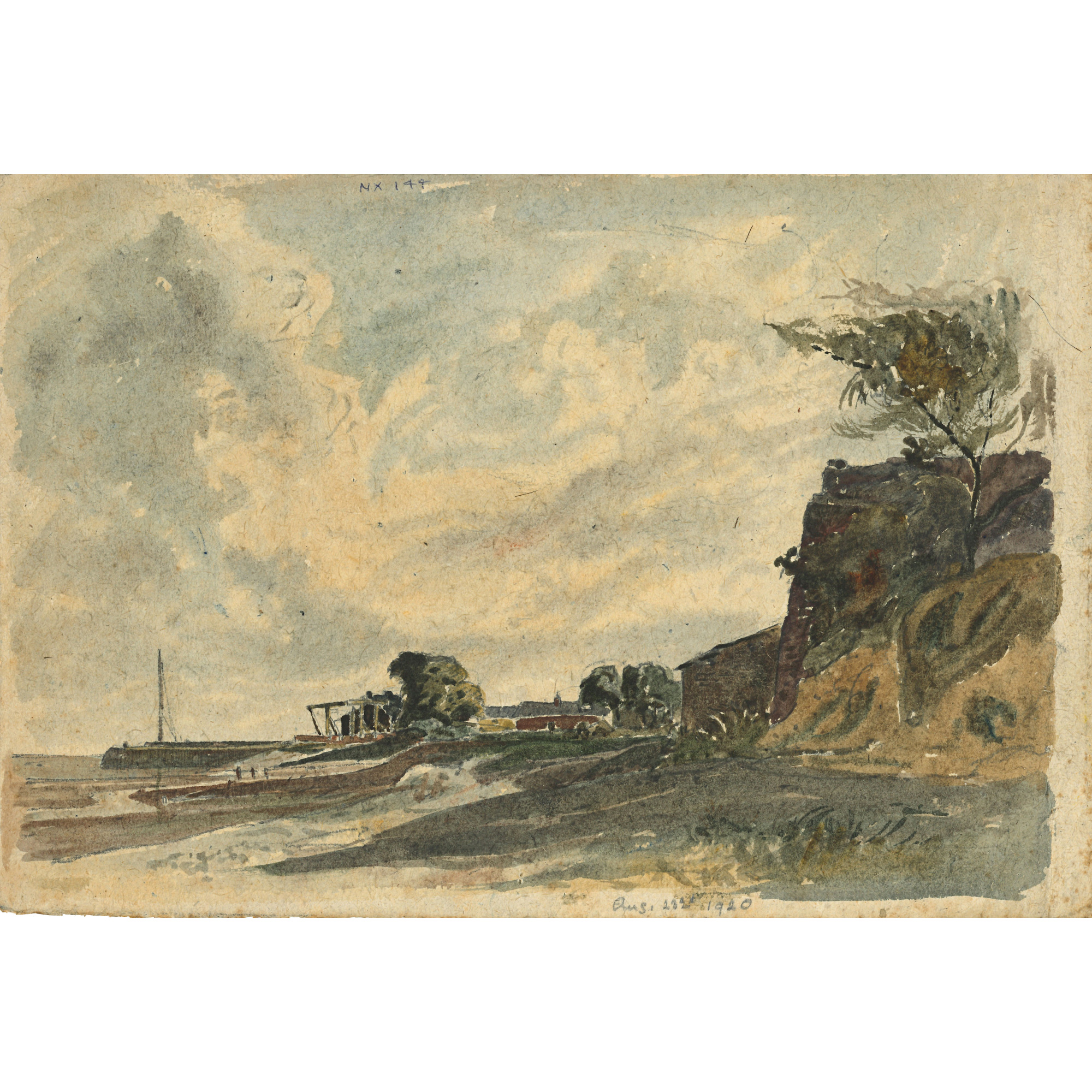
Claude Muncaster (1903-1974)
Canal Foot Ulverston Canal
Signed and titled to reverse Inscribed Aug. 23rd (?) 1920 Pen and watercolour 19x29cm Muncaster's watercolours capture the English countryside feel with great competence. Here he records the old swing bridge across the lock at the foot of the now-derelict Ulverston Canal. It was Britain's straightest canal, running two miles from Morecambe Bay to Ulverston but has long stood unused. Click here for biographical details and other works by the artist. If you are interested email info@manningfineart.co.uk or call us on 07929 749056. -
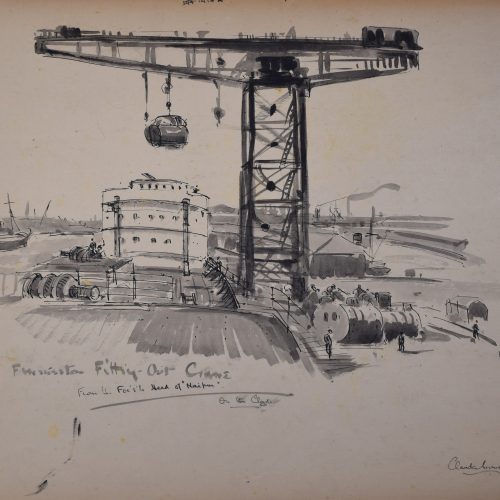
Claude Muncaster
Finniston Crane, Glasgow (1954) Pen and ink drawing If you are interested email info@manningfineart.co.uk or call us on 07929 749056. -
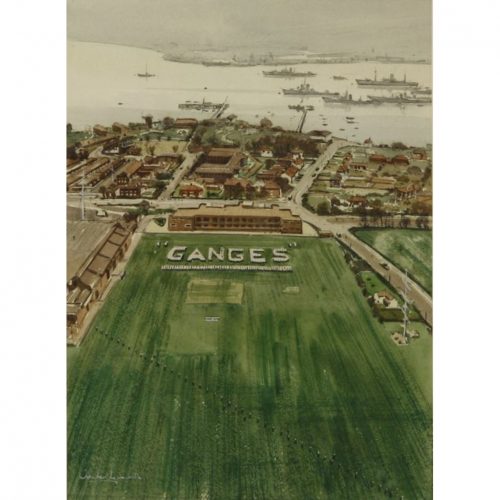
Claude Muncaster (1903-1974)
HMS Ganges near Harwich as seen from a Naval Helicopter
Watercolour with touches of gouache over pencil traces 41x31cm Signed Titled and dated 1956 to reverse HMS Ganges was a shore training establishment of the British Royal Navy. A group of ratings is spelling out the word "Ganges" as a further group are lined across the field. To the right may be seen the artificial mast that cadets learned to climb. In the sea beyond stand warships and other vessels. Muncaster was particularly keen on helicopters for obtaining an alternative view of a scene Click here for biographical details and other works by the artist. If you are interested, email info@manningfineart.co.uk or call us on 07929 749056. -

Claude Muncaster
Port Alleyway, City of New York, August (1948)
Pen and watercolour Signed 20x28cm Provenance: Martin Muncaster, the artist's son. Click here for biographical details and other works by the artist. If you are interested email info@manningfineart.co.uk or call us on 07929 749056. -
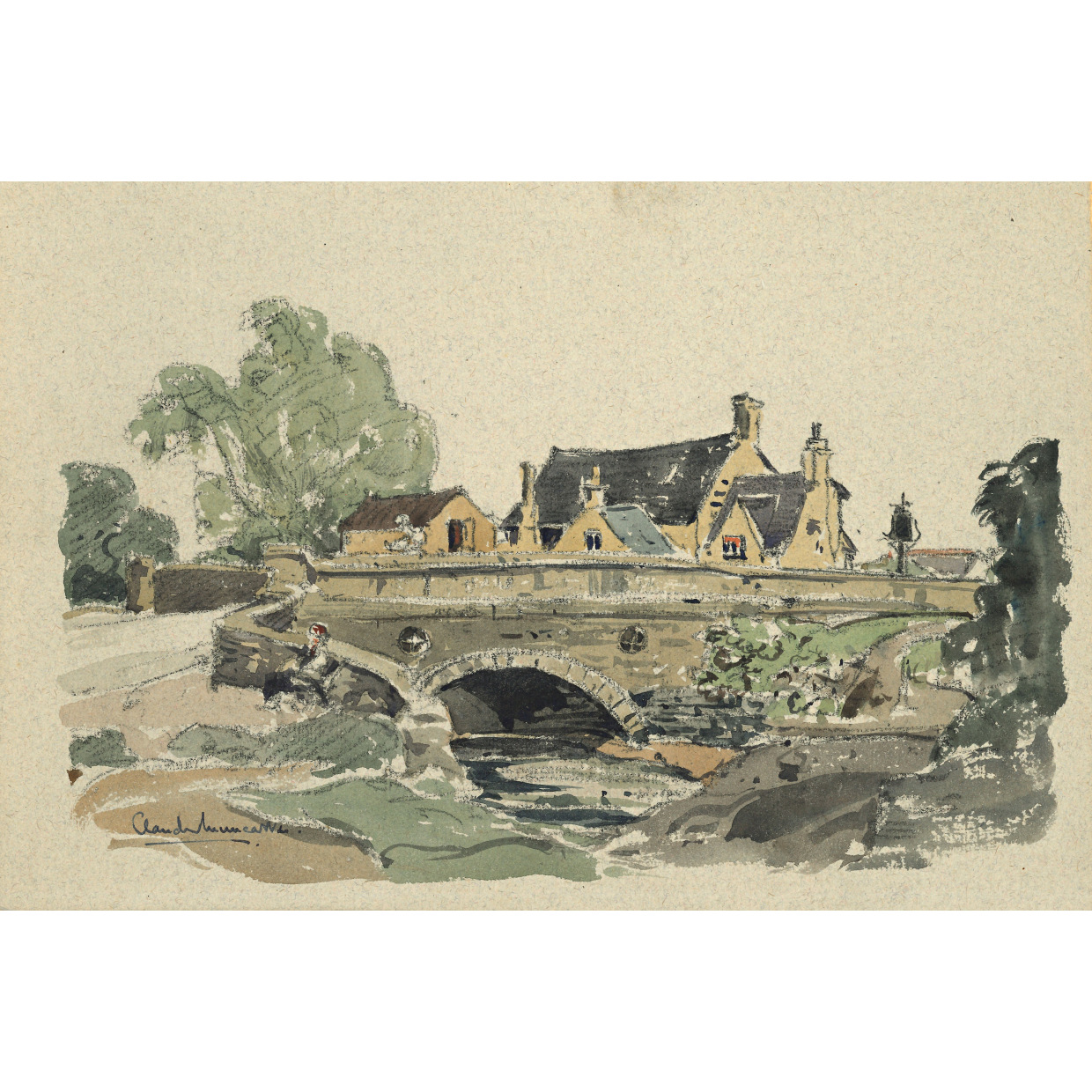
Claude Muncaster (1903-1974)
The Old George Inn South Cerney
Dated October 1952 to reverse Signed lower left and further signed to reverse Pencil and Watercolour 20x30cm Muncaster's watercolours capture the English countryside feel with great competence. Click here for biographical details and other works by the artist. If you are interested email info@manningfineart.co.uk or call us on 07929 749056. -
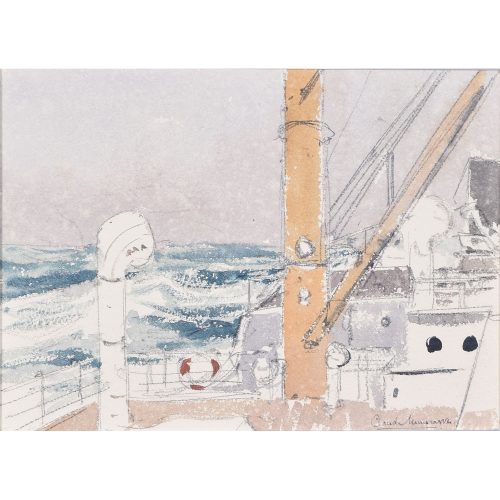
Claude Muncaster
Storm on City of Exeter, Ellerman Line (Passing through the Bay of Biscay), 1948
Signed Watercolour and pencil 21x28cm Provenance: Martin Muncaster, the artist's son. Click here for biographical details and other works by the artist. If you are interested email info@manningfineart.co.uk or call us on 07929 749056. -
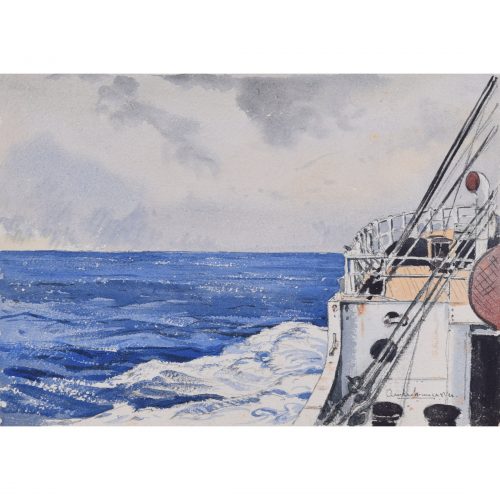
Claude Muncaster
The Bow Wash
Pen and watercolour 21x28cm Framed Provenance: Martin Muncaster, the artist's son. Click here for biographical details and other works by the artist. If you are interested email info@manningfineart.co.ukor call us on 07929 749056. -
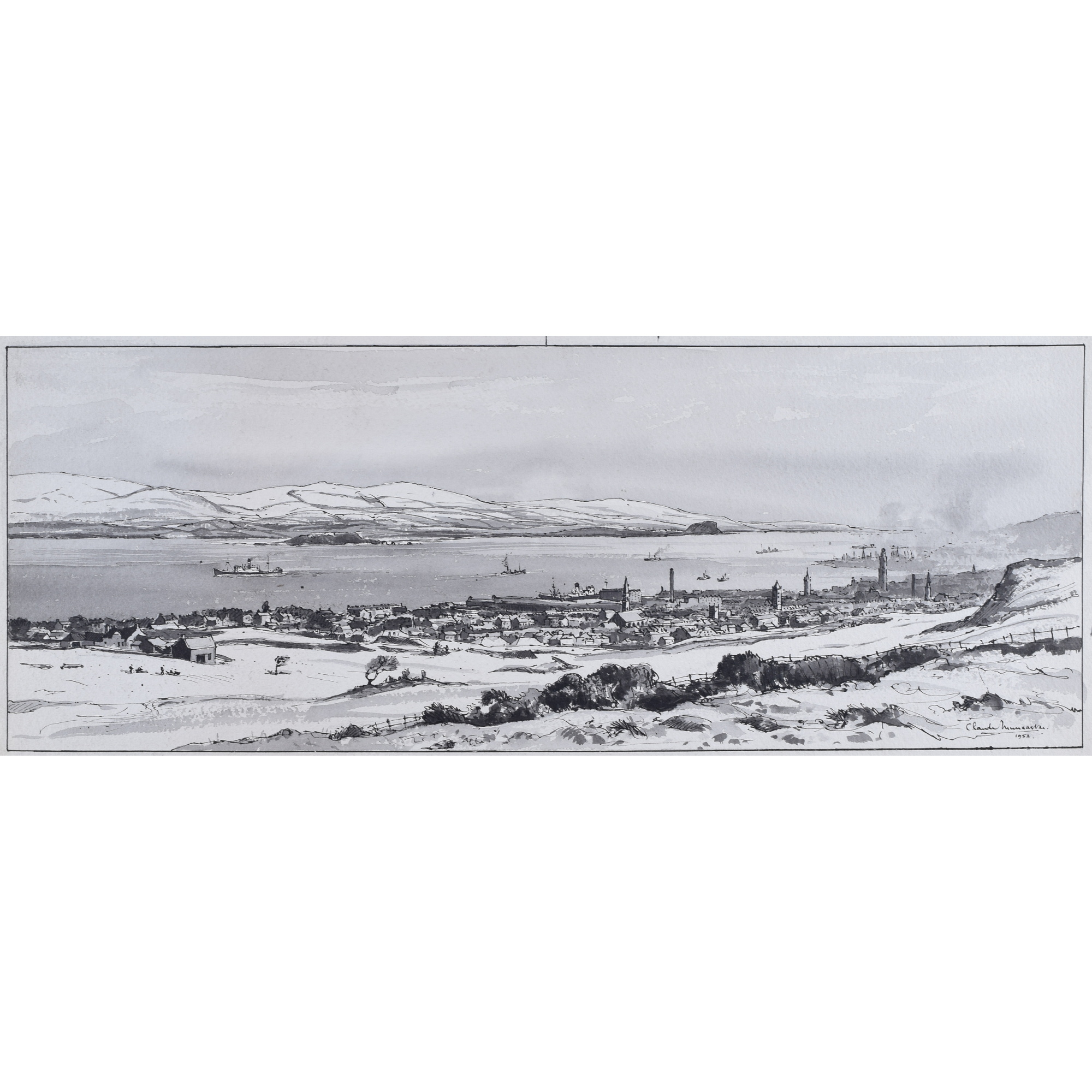
Claude Muncaster (1903-1974)
View of the Clyde from Lyle Hill
Monochrome watercolour with ink Signed and dated 1952, and inscribed 'Sphere' 18x50cm DRAWN FOR 'THE SPHERE' ILLUSTRATED MAGAZINE Click here for biographical details and other works by the artist. If you are interested email info@manningfineart.co.uk or call us on 07929 749056. -
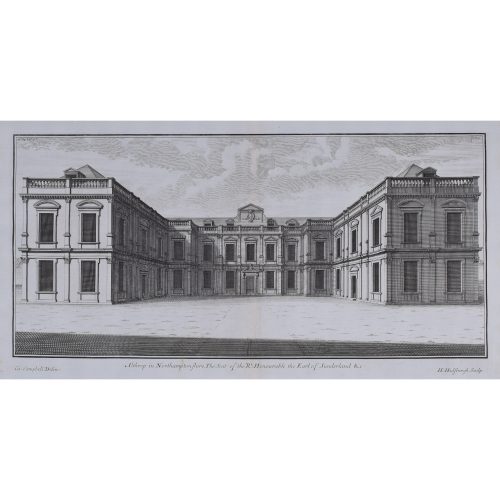
Colen Campbell (1676-1729)
Althrop Hall in Northamptonshire the Seat of the Rt Honourable The Earl of Sunderland & co.
35x50cm Engraving (1715-1725) from 'Vitruvius Britannicus, or the British Architect...' Althorp Hall - as it is now written, but still pronounced 'Althrop' - is the seat of the Earl Spencer and the location of the grave of Diana, Princess of Wales. Colen Campbell was a Scottish architect and architectural writer, renowned for being a founder of the Georgian style. His major published work was 'Vitruvius Britannicus' which was a catalogue of design, containing a series of engravings of English buildings by Inigo Jones, Sir Christopher Wren, Campbell himself and other prominent architects of the era. It was published in three volumes between 1715 and 1725. -
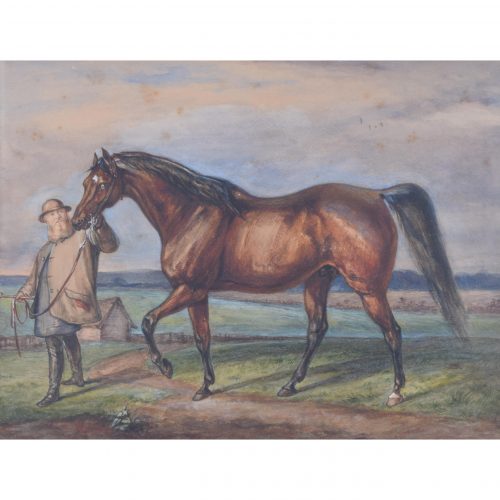
H. Fluiss
Cotherstone with stud groom "Wilson" (1862)
Watercolour 30 x 39 cm A late-nineteenth century watercolour depicting Cotherstone, the British Thoroughbred racehorse and sire. In a career that lasted from September 1841 to July 1843, he ran eleven times and won eight races. Provenance: Christie's South Kensington (2002). Condition: generally very good; couple of faint spots to sky. Frame in "country house" condition. If you are interested, please email info@manningfineart.co.uk or call us on 07929 749056. -
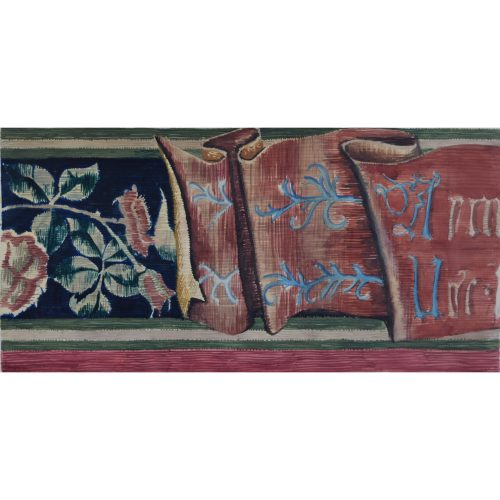
D. L. Hadden
Design for tapestry
Watercolour 25x50cm If you are interested email info@manningfineart.co.uk or call us on 07929 749056. -
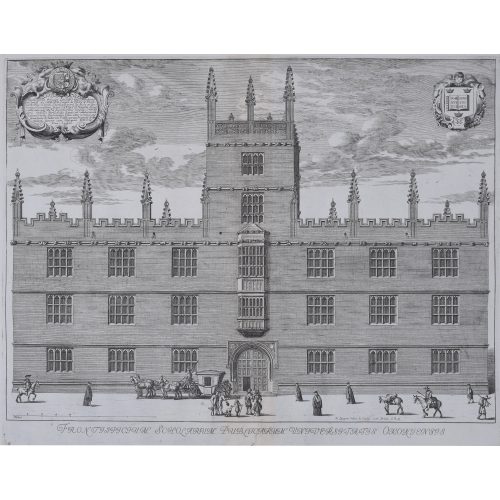
David Loggan (1634-1692)
Frontispiece Public Schools Oxford
Engraving 33x42cm If you are interested email info@manningfineart.co.uk or call us on 07929 749056. -
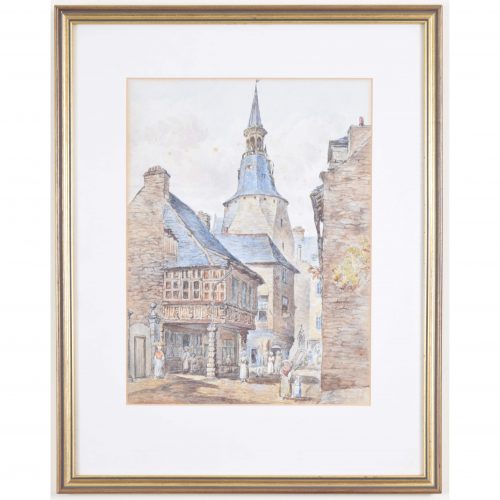
Attributed to Antony Vandyke Copley Fielding (1787 - 1855)
Dinan Tour de l’Horloge (Dinan Clock Tower)
Watercolour 28 x 21 cm A spirited watercolour of Dinan, Brittany. Dinan's famous clock tower looks over a French street scene: men, women, and children weave through the town's half-timbered houses, shops, and ateliers. The characterful mediaeval stonework and architecture of the town are paramount, and the artist adds a bright blue hue to his depiction of Dinan's roofs. Dinan is a walled medieval Breton town and commune in the Côtes-d'Armor department of northwestern France. Enclosed by nearly three kilometres of ramparts, the town and its 14th-century castle proudly overlook the Rance river. Anthony Vandyke Copley Fielding, commonly called Copley Fielding, was an English painter famous for his watercolour landscapes. At an early age Fielding became a pupil of John Varley. In 1810 he became an associate exhibitor in the Old Watercolour Society (later known as the Royal Society of Watercolours), in 1813 a full member, and in 1831 the Society's President. In 1824 he won a gold medal at the Paris Salon, alongside Richard Parkes Bonington and John Constable. Examples of his work are held by the Victoria and Albert Museum and other major museums in Britain. Condition: good. Some spotting to sky; handsomely framed. If you’d like to know more, please email info@manningfineart.co.uk or call us on 07929 749056. -
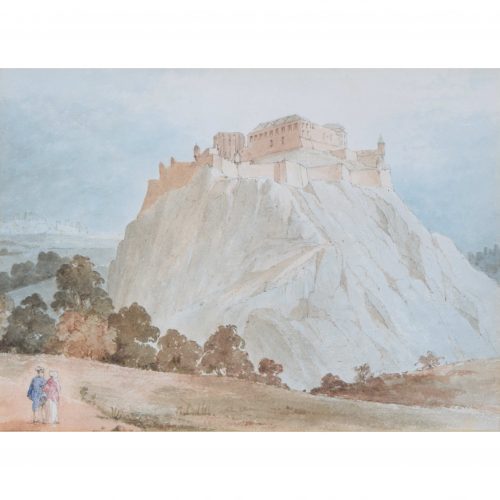
Richard Westmacott (1775 - 1856)
Edinburgh Castle (1800)
Watercolour 29 x 41 cm A watercolour depicting Edinburgh Castle. A Georgian couple gaze up at the immensity of Castle Rock, and the 11th-century fortress perched upon it. Richard Westmacott was British artist who primarily worked as a sculptor. Westmacott studied with his father, also named Richard Westmacott, at his studio in Mount Street, off Grosvenor Square in London, before going to Rome in 1793 to study under Antonio Canova. Upon his return to London in 1797, he established his own studio. He exhibited at the Royal Academy between 1797 and 1839 and was elected an associate of the Royal Academy in 1805, and a full academician in 1811. Condition: very good; handsomely framed. If you’d like to know more, please email info@manningfineart.co.uk or call us on 07929 749056. -
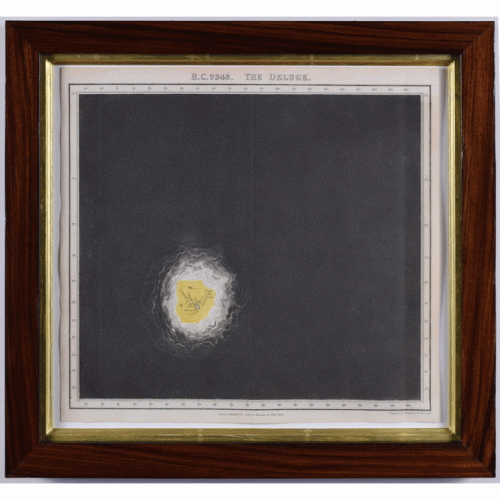
Edward Quin (British 1794-1828)
Twenty-one maps from An Historical Atlas in a Series of Maps of the World As Known at Different Periods.
Twenty-one hand-coloured engraved maps, various sizes, presented in fine hand-finished rosewood veneer frames. Click on the image to see all twenty-one maps. 15 approx 40 x 31 cm 5 approx 62 x 31 cm Seeley and Burnside np. nd. [London c. 1830] Scroll down for further information. -
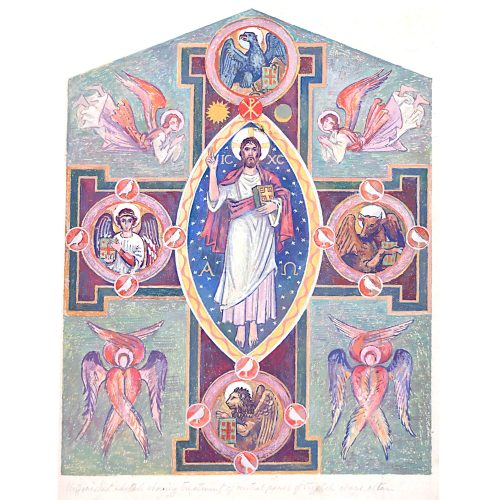
Anonymous Design for Triptych Above Alta
British, c. 1920s Gouache 38x28.5cm Christ Pantocrator stands in the middle of the design, surrounded by the four evangelists - represented by the Eagle, Bull, Lion and Angel - together with two seraphim. This is a well executed design for an as-yet unidentified location. At the bottom is a pencil description as an 'unfinished sketch'. Condition: Generally very good condition. If you are interested email info@manningfineart.co.uk or call us on 07929 749056. -
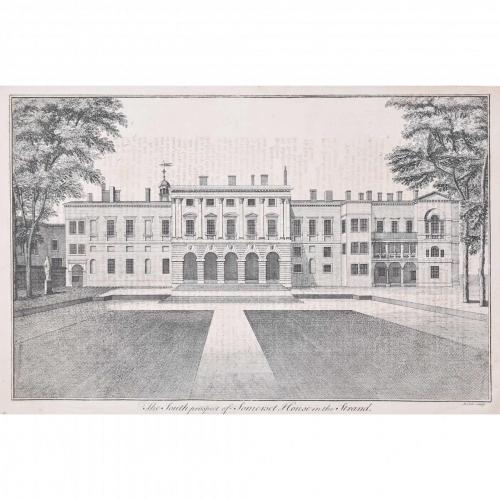
Benjamin Cole (1697-1783)
South Prospect of Somerset House (c. 1753)
Engraving 24 x 37 cm Stow's Survey of London, a ward-by-ward topographical and historical tour of the City of London giving an account of buildings, social conditions and customs, was first published in 1598. Cole's architectural view of Somerset House illustrates the clean neoclassical proportions for which it is known. Condition: Trimmed by the binder's knife within plate marks; some offsetting from facing page; occasional soft creases; generally good. -
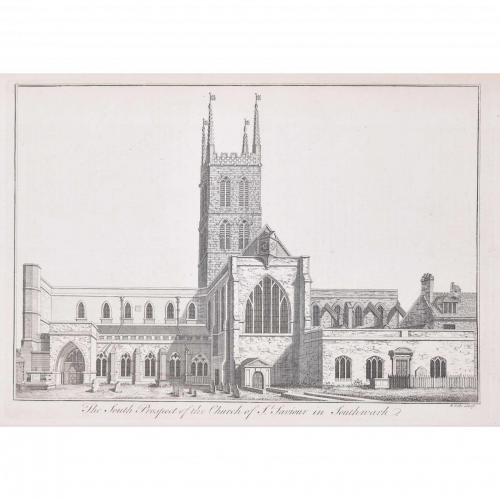
Benjamin Cole (1697-1783)
Southwark Cathedral (c. 1753)
Engraving 24 x 33 cm Stow's Survey of London, a ward-by-ward topographical and historical tour of the City of London giving an account of buildings, social conditions and customs, was first published in 1598. This view of Southwark Cathedral, labelled here as 'the South Prospect of the Church of St Saviour in Southwark', offers a charming perspective of the building's architecture and churchyard. Condition: Generally very good; slight offsetting from facing page and old library stamp to reverse. -
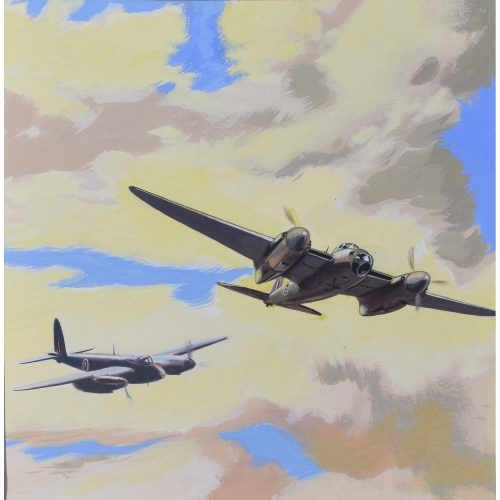
Ernest Bendell-Bayly Mosquito Fighter Bomber
Oil on paper laid on board Design for poster 32x31cm 1940s Ernest Bendell-Bayly was a partner in the Bayly-Souster advertising agency, employer of, amongst others, Owen Miller. If you are interested email info@manningfineart.co.uk or call us on 07929 749056. -
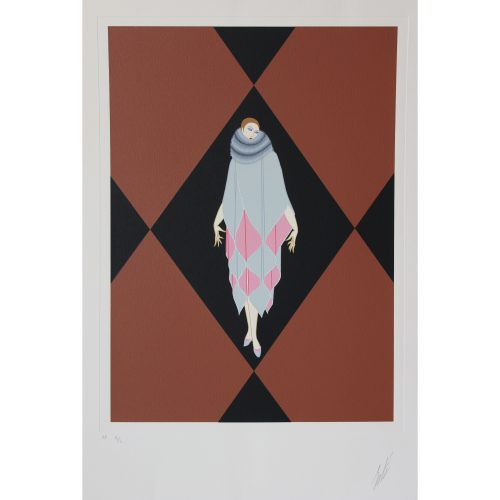
Erté (Romain de Tirtoff) (1892-1990) 'Manhattan Mary IV'
Serigraph (Artist's Proof IL/L) Signed in pencil 70 x 56cm (sheet) 41.5 x 30.5cm (plate) The Russian born Romain de Tirtoff moved to Paris around 1912 to work as a designer, choosing the pseudonym ‘Erté’ based on the French pronunciation of his initials. He produced fashion plates for the designer Paul Poiret and signed a contract with Harper’s Bazaar that saw him design over 200 covers for the magazine. Costume and stage design followed in the 1920s, for the Folies Bergeres and similar revues in Paris, then in Hollywood for Louis B. Mayer. Erté’s distinctive and elegant style came to epitomise the Art Deco era; it is characterised by a combination of sharp geometric line - like the harlequin background to this print - strong colour planes and images of fashionable modern women with close-cropped hair and asymmetric hemlines. Art Deco enjoyed a revival in the 1960s, and it was from this point that limited edition prints began to be produced from Erté’s designs. ‘Manhattan Mary’ was a Broadway musical which opened at the Apollo Theatre, New York in September 1927, with set and costume designs by Erté. If you are interested email info@manningfineart.co.uk or call us on 07929 749056. Condition: Excellent. -
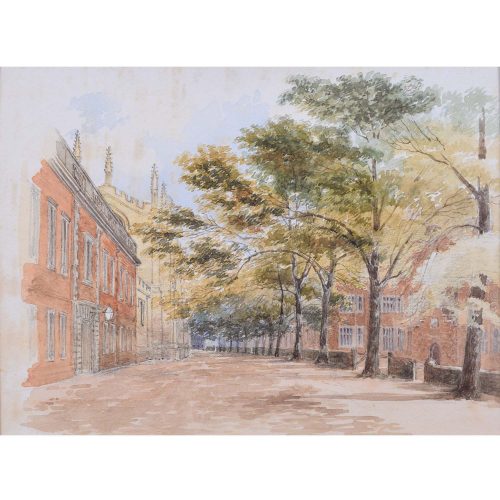
Anonymous Eton College
Watercolour 21.2×28.5cm If you are interested email info@manningfineart.co.ukor call us on 07929 749056. Condition: Good. -
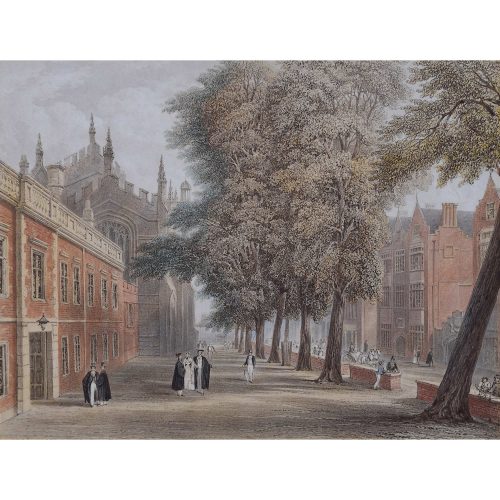
Anonymous (19th century) Eton College
Lithograph 29 x 38 cm We have a pair of these rather fine 19th century lithographs; view the other picture here. Condition: Mounted to board. -
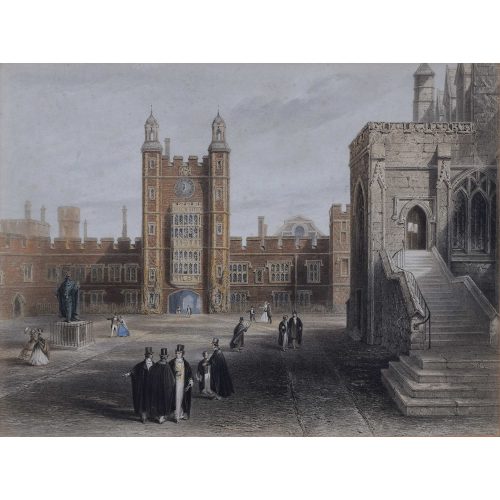
Anonymous (19th century) Eton College Courtyard
Lithograph 29 x 38 cm We have a pair of these rather fine 19th century lithographs: see the second one here. Mounted to board. -
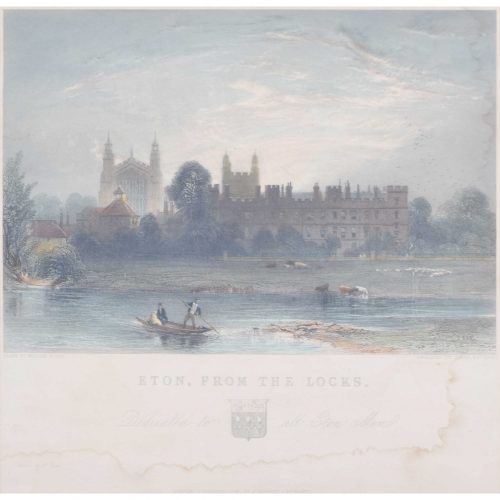
James Redaway (1797 - 1858)
Eton from the Locks
Hand-coloured engraving 27 x 28 cm Redaway's view of Eton College, seen from the locks on the River Thames. James Redaway was a nineteenth-century engraver, principally of landscapes and architectural subjects. Condition: some staining to lower half of print. If you’d like to know more, please email info@manningfineart.co.uk or call us on 07929 749056. -
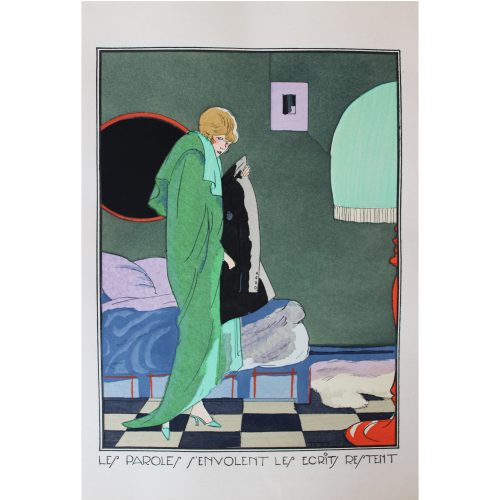
After Ettore Tito (1859-1941) c.1920s A set of four pochoir prints: 'Les paroles s'envolent les ecrits restent'; 'On a souvent besoin d'un plus petit que soi'; 'Qui trop embrasse...'; 'Aide-toi le ciel t'aidera'
23.5 x 16.5 cm (to mount) Ettore Tito (1859-1941) Tito trained at the Accademia di Belle Arti in Venice and later became a professor there, known for his landscapes and scenes of traditional life in the Veneto region, as well as producing several larger mythological murals notably for the Villa Berlinghieri in Rome and the Chiesa degli Scalzi in Venice. He associated with an expatriate artistic milieu that included John Singer Sargent and Isabella Stewart Gardner. However, in the 1920s he also produced these pochoir prints of emancipated women for a French magazine which were considered rather risqué at the time! If you are interested email info@manningfineart.co.ukor call us on 07929 749056. Condition: Excellent, mounted. -
 Frank Algernon Stewart (1877-1945) The Heythrop at Stow on the Wold Lithograph 24 x 63cm Signed in pencil. Framed. A typical hunting print by Stewart, showing one of the country's leading packs. Condition: Slight, even, loss of colour, as expected. If you’d like to know more, please email info@manningfineart.co.uk or call us on 07929 749056.
Frank Algernon Stewart (1877-1945) The Heythrop at Stow on the Wold Lithograph 24 x 63cm Signed in pencil. Framed. A typical hunting print by Stewart, showing one of the country's leading packs. Condition: Slight, even, loss of colour, as expected. If you’d like to know more, please email info@manningfineart.co.uk or call us on 07929 749056. -
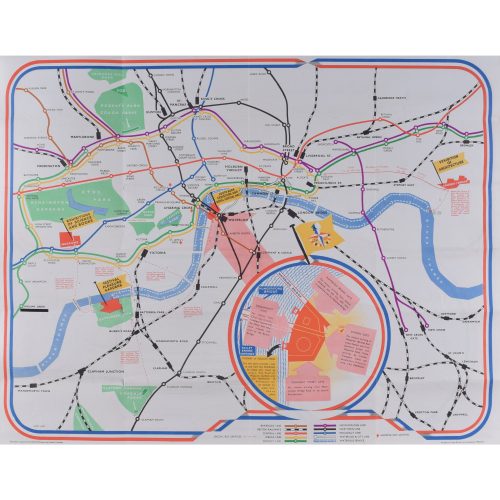
James Hart
Festival of Britain
Lithographic poster map 45 x 58 cm Folding map published for London Transport and British Railways for visitors to the 1951 Festival of Britain, featuring the Abram Games logo, details of water bus services, a detailed plan of the Lambeth exhibition area by Waterloo Bridge. If you are interested email info@manningfineart.co.uk or call us on 07929 749056. -
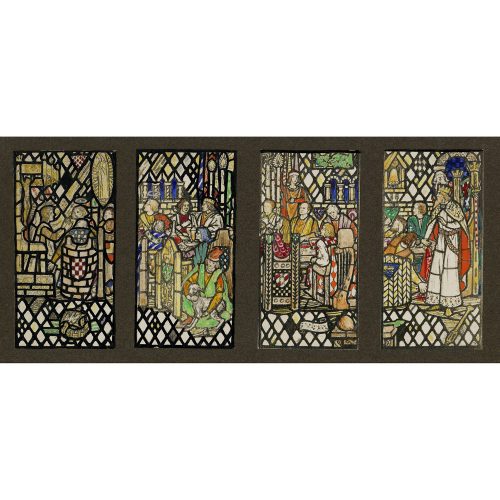
Florence & Walter Camm
Design for Series of Four Arthurian Stained Glass Windows for Mercersburg Academy Chapel, Pennsylvania
1928 Watercolour over photographic background 10 x 24cm Provenance: The archives of TW Camm The Irvine Chapel of Mercersburg Academy was built as a war memorial for the First World War dead of the school. The dead were honoured in a series of stained glass windows that were commissioned from a series of the greatest stained glass designers of the time. If you are interested email info@manningfineart.co.uk or call us on 07929 749056. -
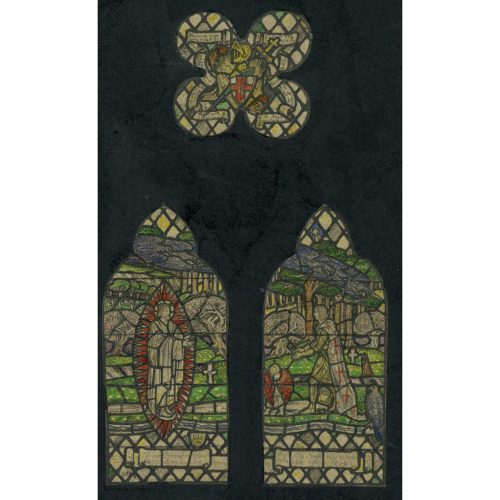
Florence Camm (1874-1960)
Arthurian Stained Glass Window Design II
Watercolour 16x9.5cm Design for TW Camm & Co., Smethwick, Birmingham. If you are interested email info@manningfineart.co.uk or call us on 07929 749056. -
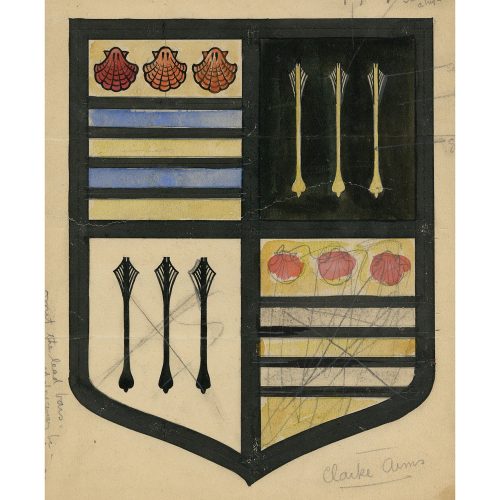
Florence Camm (1874-1960)
Clarke Arms Design
Watercolour and pencil 22x17cm Design for TW Camm & Co. If you are interested email info@manningfineart.co.uk or call us on 07929 749056. -
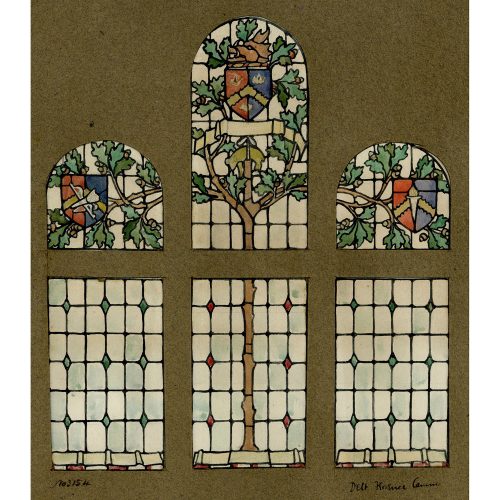
Florence Camm (1874-1960)
Heraldic Stained Glass Window Design with Oak Leaves
Watercolour 20x18cm Click for biographical details and other works by Camm. If you are interested email info@manningfineart.co.uk or call us on 07929 749056. -
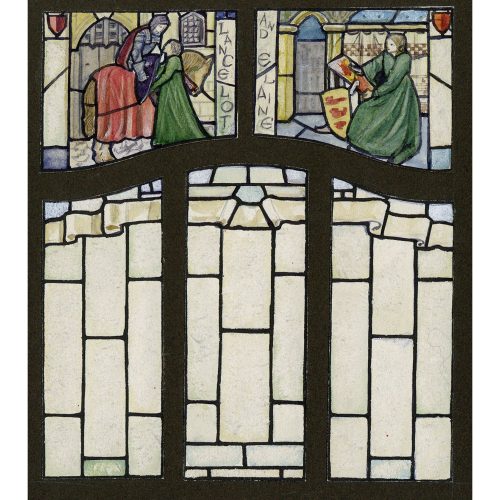
Florence Camm (1874-1960)
Lancelot and Elaine Stained Glass Window Design
Watercolour 13.5x11.5cm Design for TW Camm & Co., Smethwick, Birmingham. If you are interested email info@manningfineart.co.uk or call us on 07929 749056. -
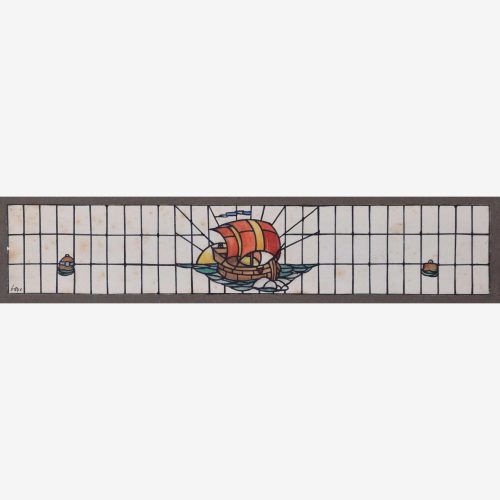
Florence Camm (1874-1960)
Stained Glass Window Design with Red Sailing Ship
Watercolour 6.5x34cm Condition: Some spotting to image; mounted to board - see image. Click for biographical details and other works by Camm. If you are interested email info@manningfineart.co.uk or call us on 07929 749056. -
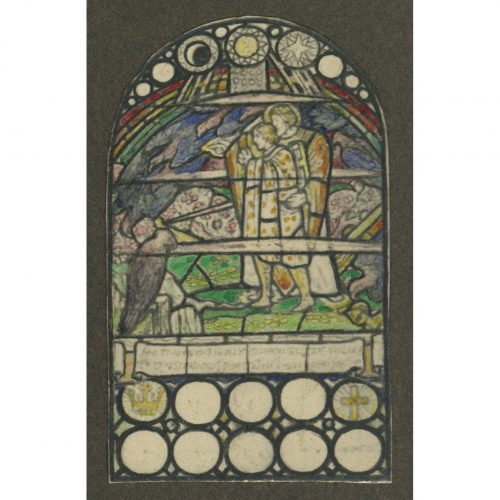
Florence Camm (1874-1960)
Valley of the Shadow of Death Stained Glass Window Design for Wrekin College (1936)
Watercolour 9x6cm Design for TW Camm & Co., Smethwick, Birmingham. If you are interested email info@manningfineart.co.uk or call us on 07929 749056. -
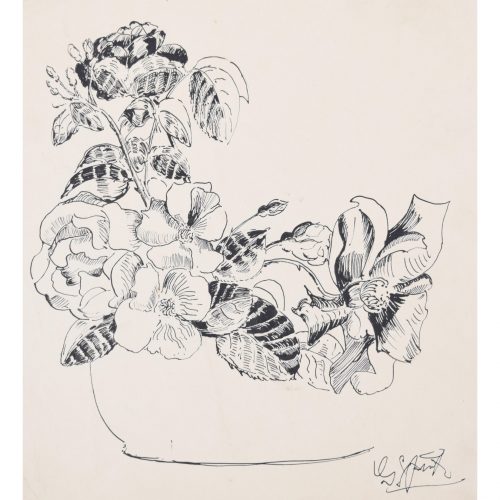
Gerald Mac Spink (flourished 1920 - 1940)
Flowers
Pen and ink 15 x 23 cm Signed 'G Spink' lower right. Spink was a skilled artist, illustrator, and designer who produced a series of posters in the inter-war period for companies including the London Underground, Southern Railways, LNER, Hawker Engineering, and British Steel. He won a prize in 1933 from the Imperial Institute for his poster artwork. He also worked as an aeronautical engineer in Kingston-on-Thames for Hawker Engineering; his greatest achievement was the creation of the 'Squanderbug', a 500cc racing car which he built in 1947, and which races even to this day. Provenance: the artist's estate. Condition: generally very good. If you are interested, please email info@manningfineart.co.uk or call us on 07929 749056. Click here for other works by the artist.

